The road wasn’t as busy as I had thought it would be at 5 a.m. I suppose it’s because several people traveled up to agate Fossil Beds National Monument the night before and many more came later in the day.
About 10 miles before the park, cars, trucks and RVs dotted the sides of the road. They were all out of state vehicles. Most were pulled off the road and parked against fences. The fences are to keep livestock in. It doesn’t mean it’s free land to park your car or pitch your tent. But they did so anyway.
It angered me in a way. It’s great that people travel from places far away to see an eclipse at a great site, but disrespecting others and their land rubs me the wrong way.
Later in the day, I heard one gentleman say, “We’re so far out in the middle of nowhere, the owners, if there even are any, probably wouldn’t have seen us anyway.”
I was wearing my Star-Herald polo shirt and I was working. I chose to let that comment go. I also didn’t want it to ruin my day.
I turned into the park. The rangers smiled as they saw me. My day was already better. This is a photo essay of my day. I wrote two stories for the Star-Herald, took more than 700 photographs, met some new people, and experienced a phenomenal event.
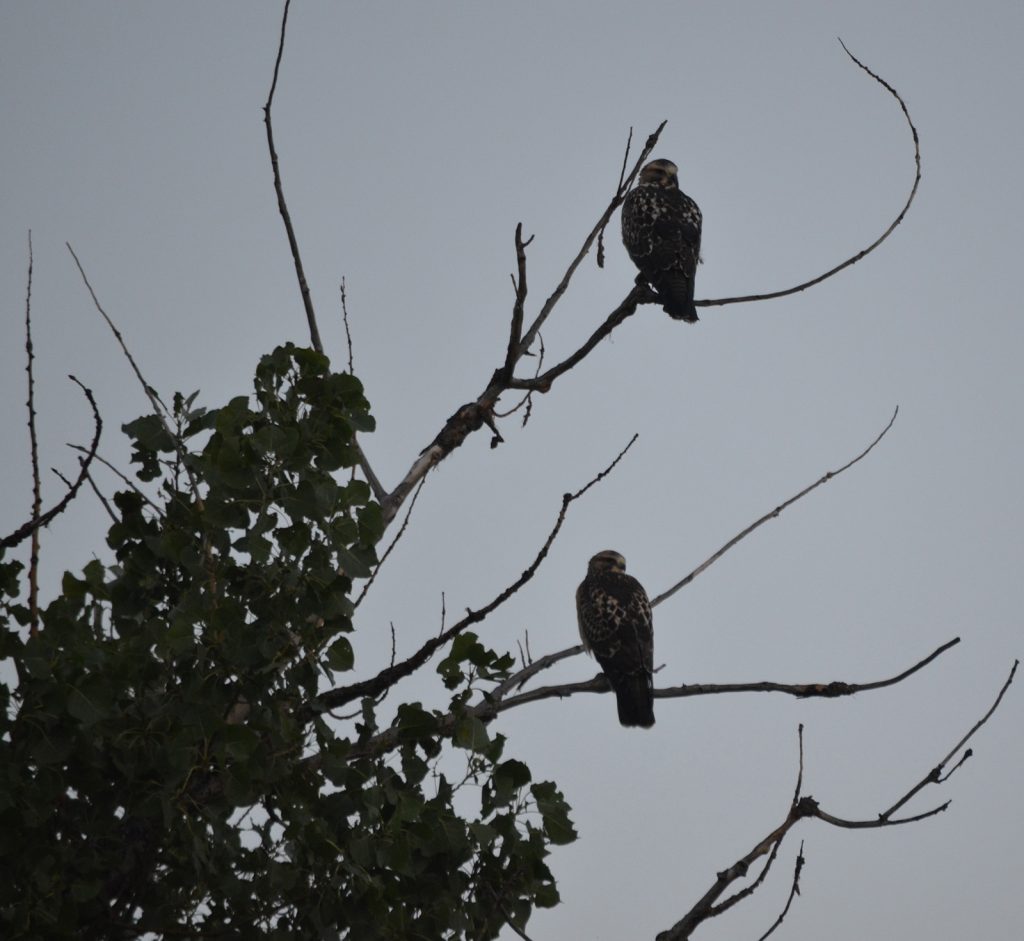
As we began our day at Agate Fossil Beds National Monument, three hawks (one is hidden within the leaves) rested in a tree near Park Ranger Alvis Mar’s home. Mar allowed us to park our car at his home. It’s 6:04 a.m.
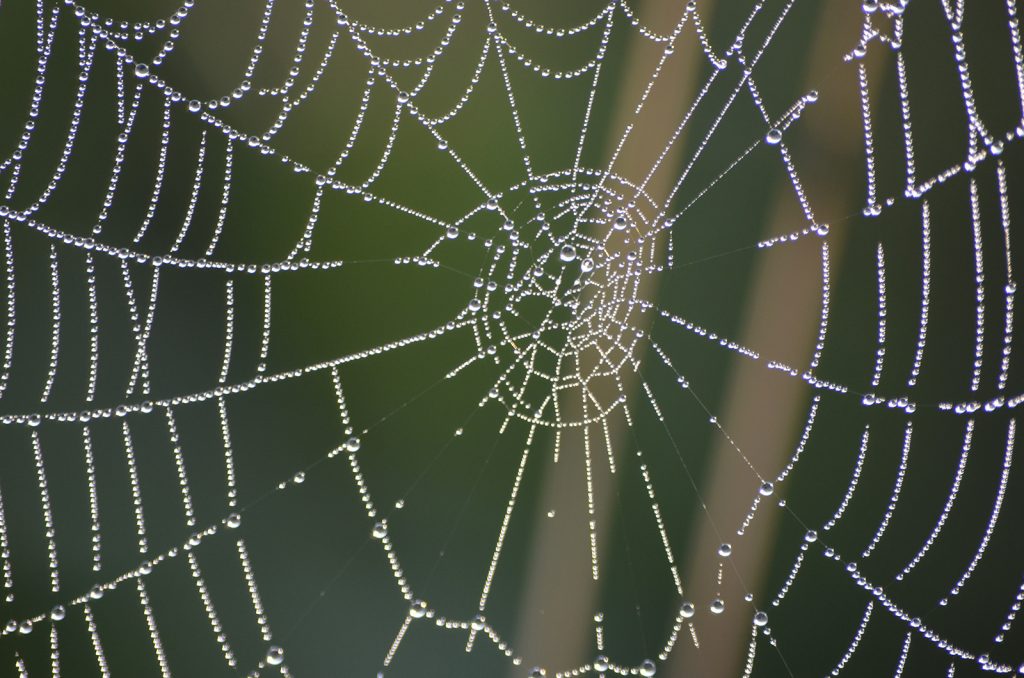
A spider web can be clearly seen thanks to the early morning dew at Agate Fossil Beds National Monument.
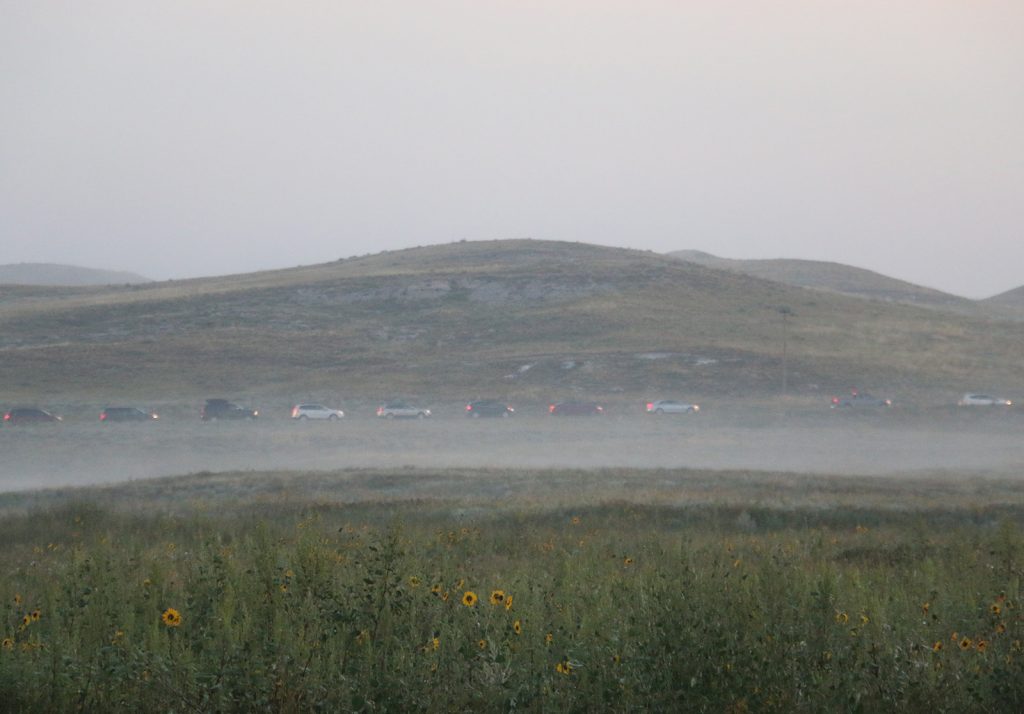
Cars line the road to the visitors center at Agate Fossil Beds National Monument at 6:05 a.m., Monday, August 21, 2017. Paul and I are walking on a service road within the park.
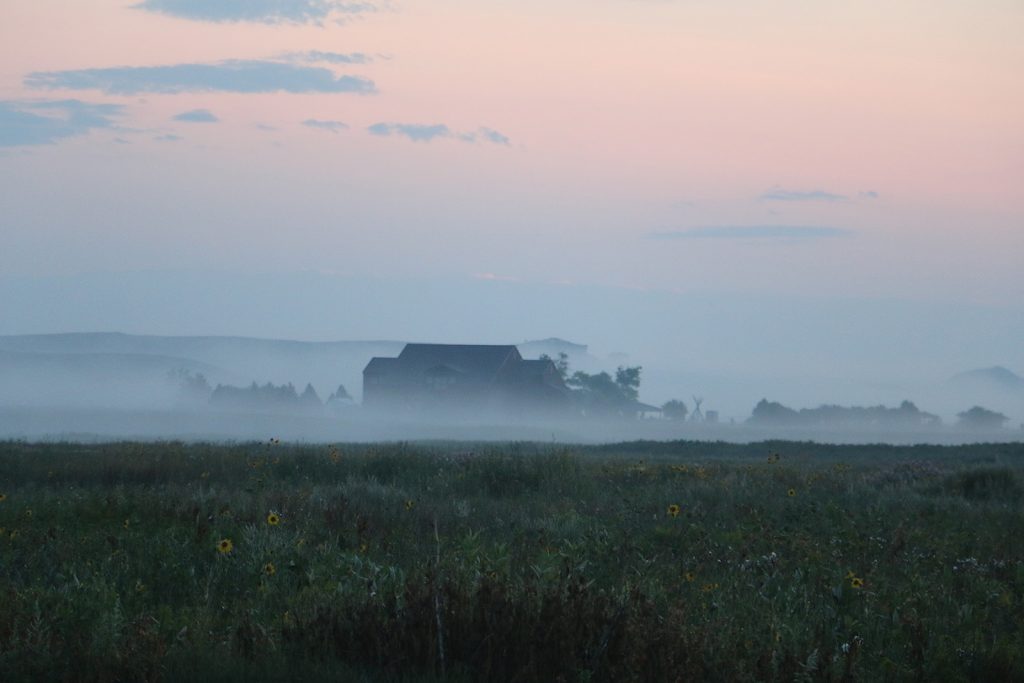
Moments before sunrise, the visitors center at Agate Fossil Beds National Monument is still obscured in fog. It is 6:06 a.m.
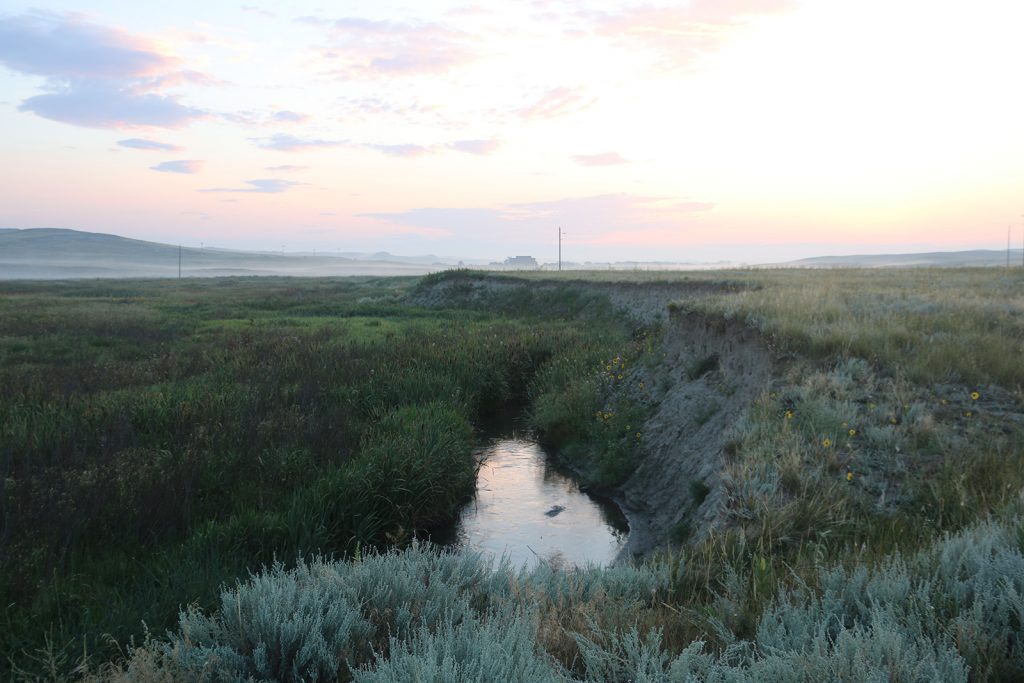
The sun is nearly here as the waters of the Niobrara River are gently moving at Agate Fossil Beds National Monument.
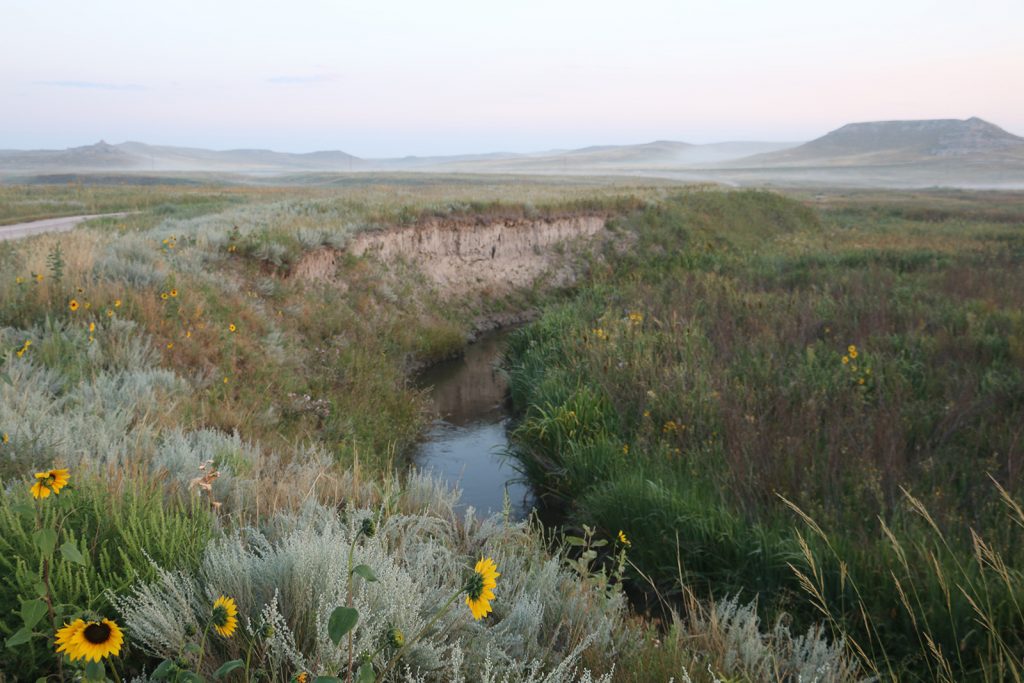
I know it’s two photos of the Niobrara River, but this is a different angle from the photo before. It is 6:14 a.m. at Agate Fossil Beds National Monument on August 21, 2017. Eclipse day.
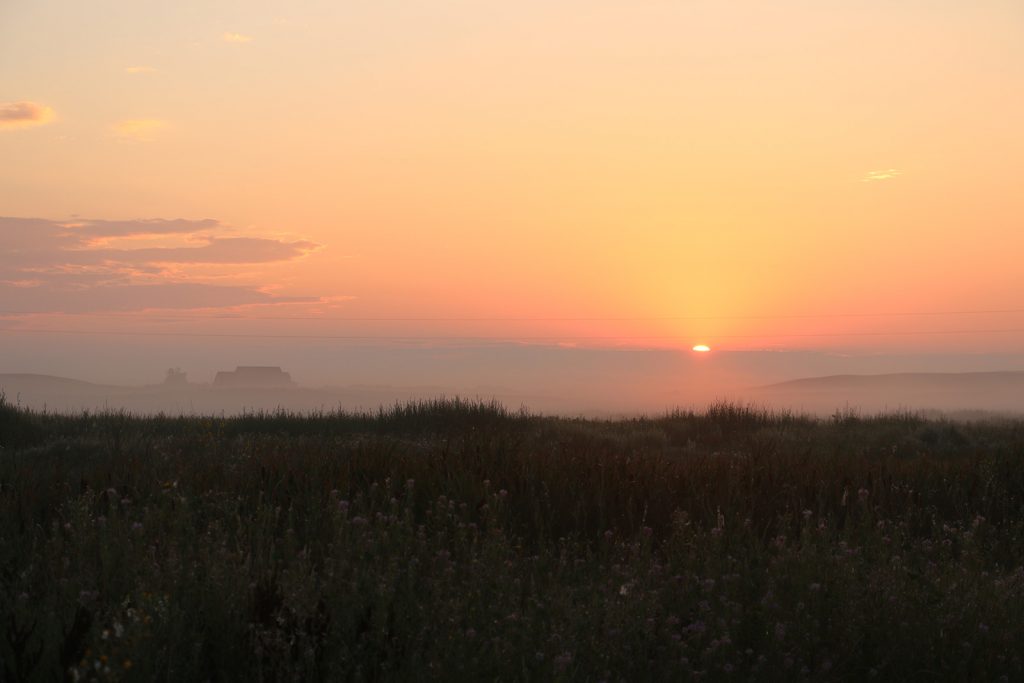
The sun peeks over the horizon at Agate Fossil Beds National Monument. The visitors center and the sun are partially obscured by fog. It is 6:17 a.m.
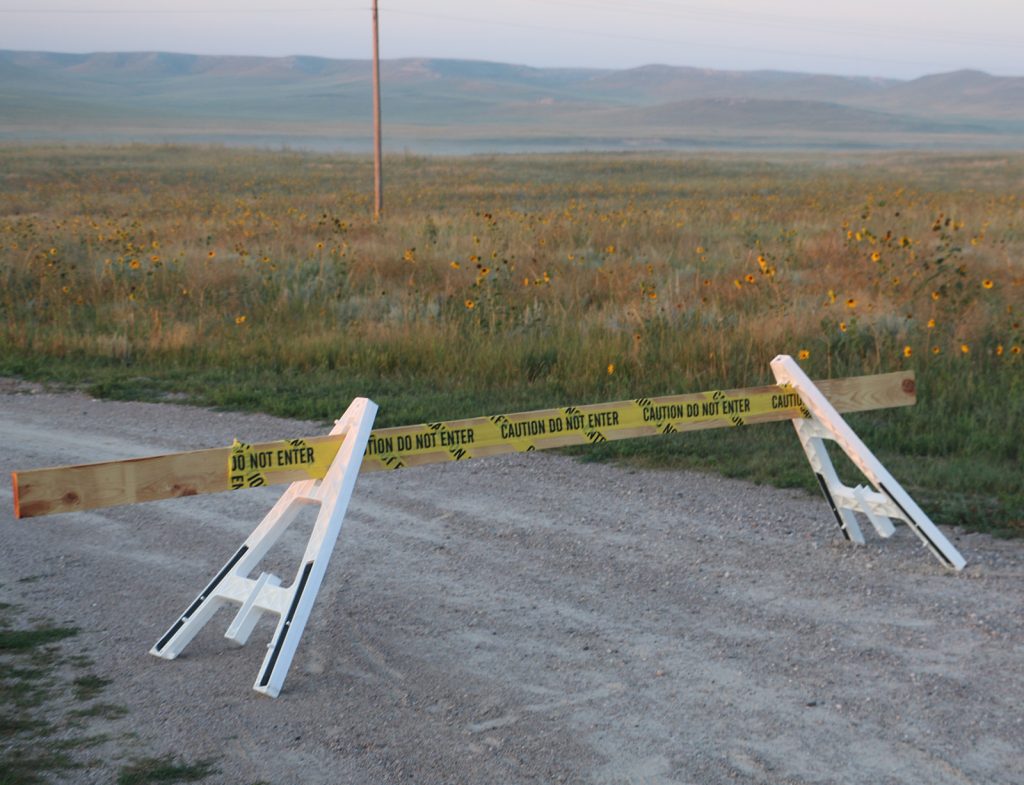
Taken from the view of the road, Paul and I finally reach the end of the service road at Agate Fossil Beds National Monument. We now begin our walk to the visitors center, about a mile away.

Someone who camped out at Agate Fossil Beds National Monument goes for a run at 6:41 a.m. I am able to just glimpse this man. Paul and I were picked up by the Scotts Bluff National Monument shuttle, which was on loan to Agate Fossil Beds National Monument for the day. This photo was taken while the shuttle was moving.
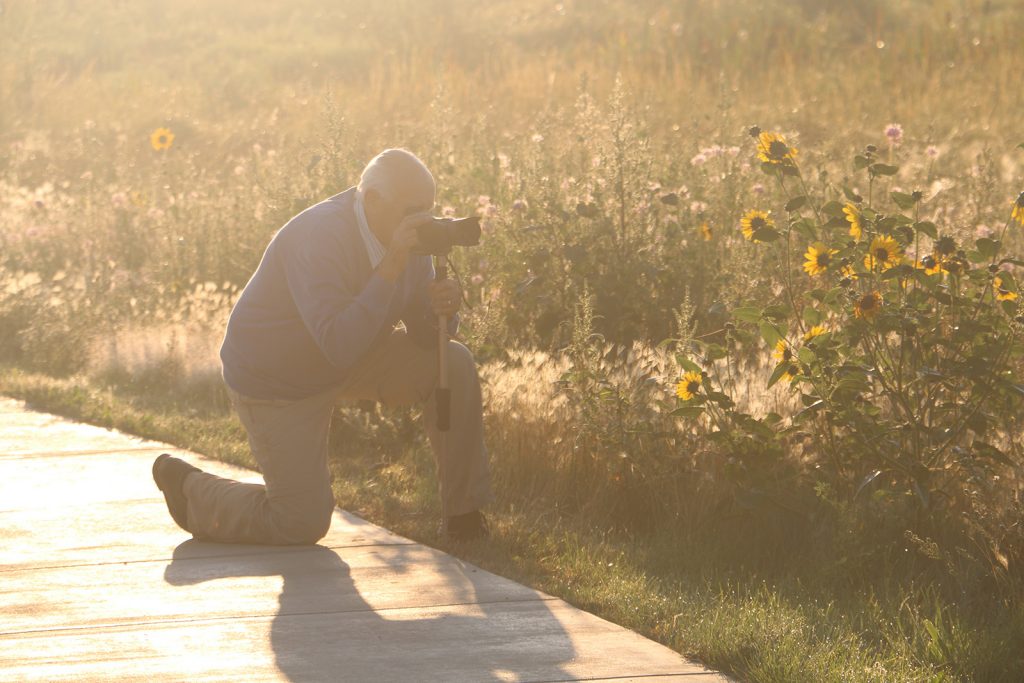
This gentleman was taking photos of sunflowers. The bright morning sun made for unique photo opportunities at Agate Fossil Beds National Monument. It is now 6:58 a.m.
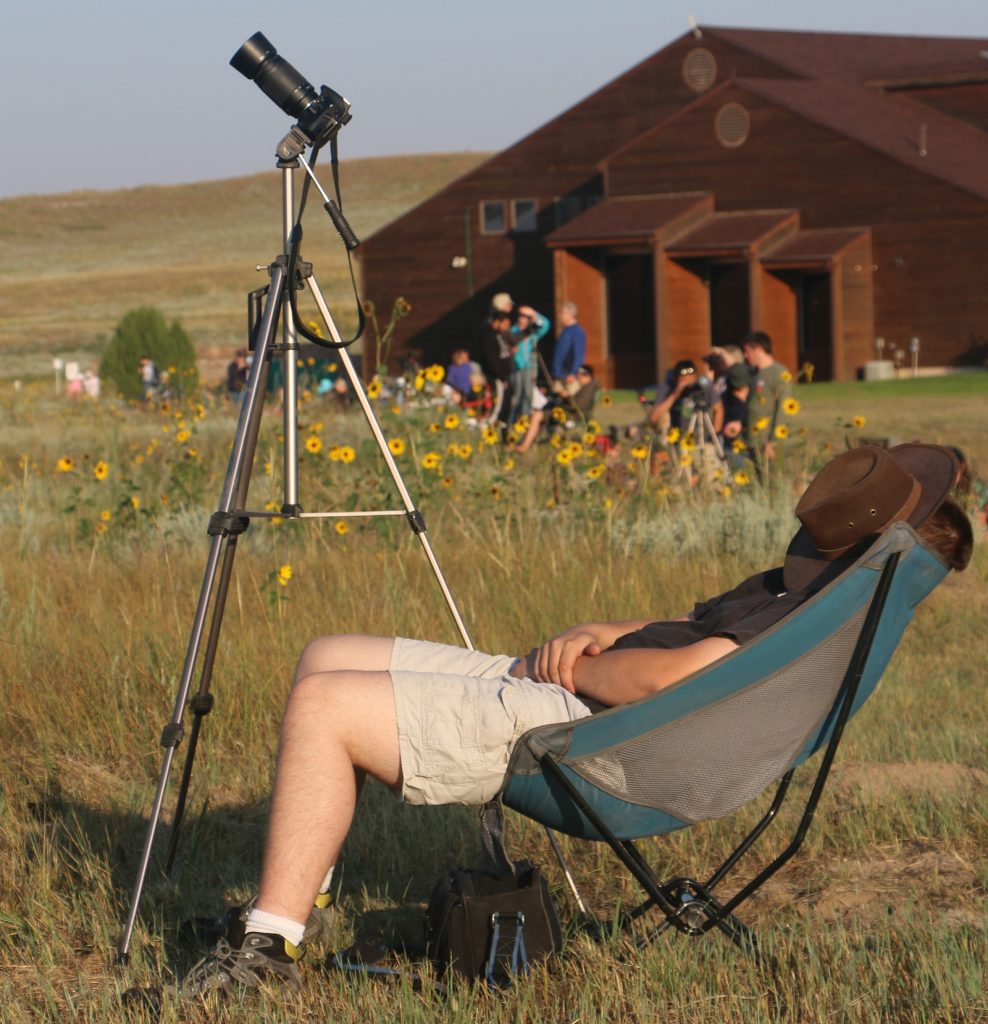
This guy was one of many who arrived early, staked out their spot for the total solar eclipse and then promptly took a nap. It is 7:16 a.m. at Agate Fossil Beds National Monument. In a little over three hours, a total solar eclipse will begin.

Chuck Cynamon with Citizen CATE looks like he’s running around his telescope, but he’s really making final calculations for his project. He arrived at Agate Fossil Beds National Monument at 3:15 a.m., Monday, August 21, 2017.
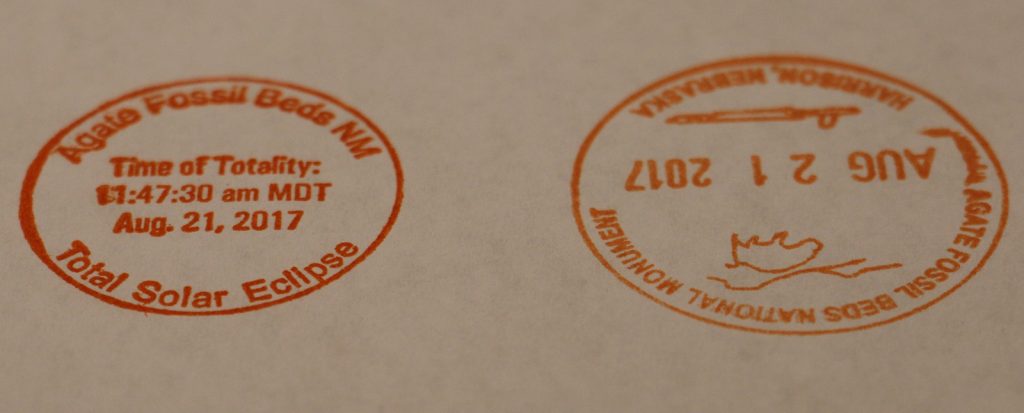
These two stamps were made available to the public for the day. The stamp on the left was only available on August 21, 2017. The stamp on the right is the normal stamp for visitors. Many people stamped both into their National Parks passports. Others stamped them onto a piece of paper like you see in the photograph.
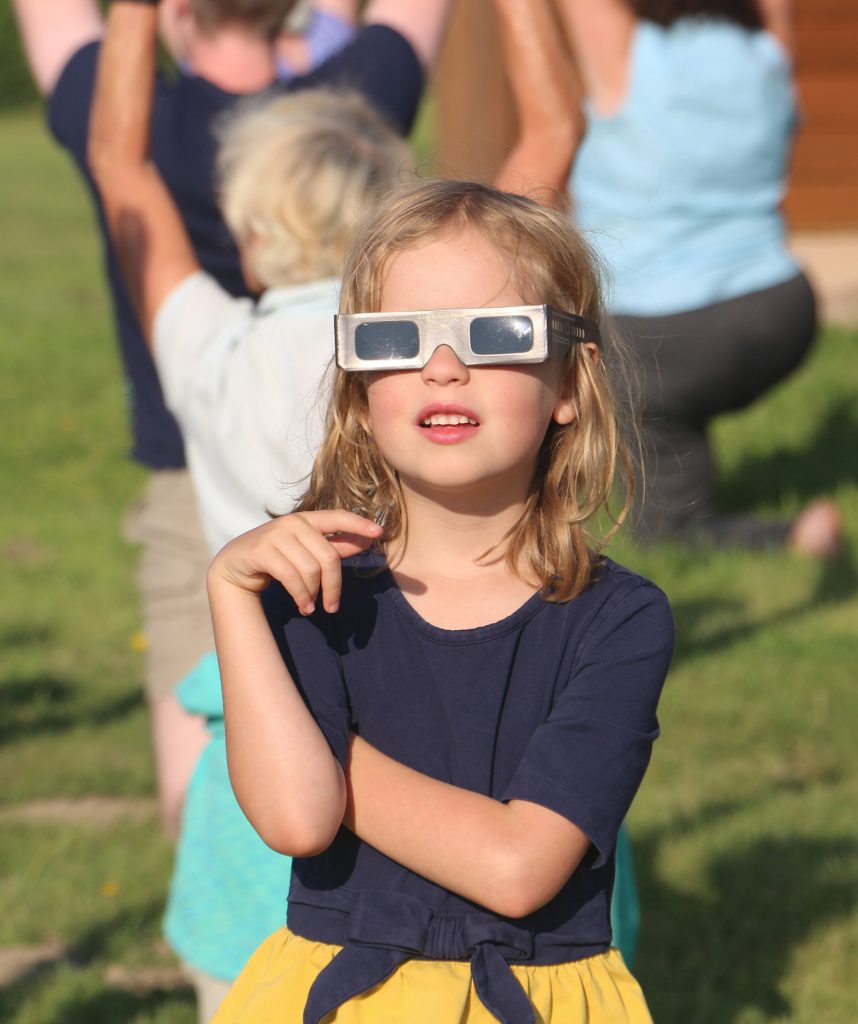
While people did yoga, Aurora McCord, of Denver, looked at the sun. She and her father, Matt, left Denver at 3 a.m. to make it Agate Fossil Beds National Monument in time for the total solar eclipse.

This is the only meal I had on eclipse day. It was really good. It’s 8:25 a.m. Eclipse starts in two hours.
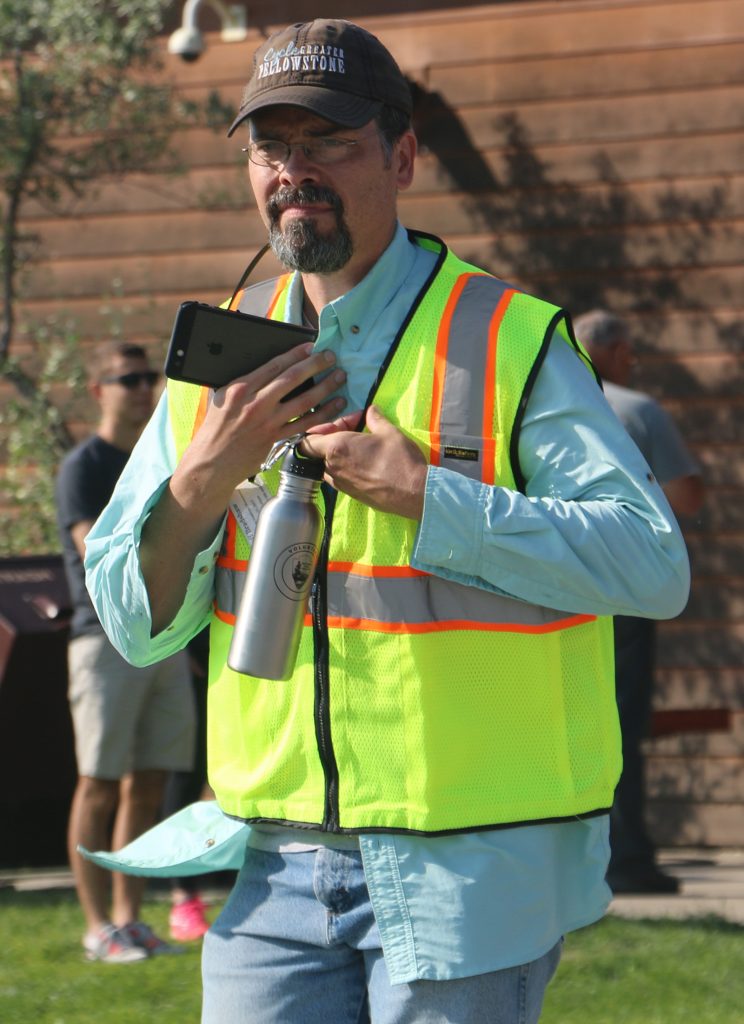
Volunteer Jeff Bradshaw attempting to hide his phone. Sorry Jeff. You’ll have to find a new hiding place now that the whole world knows.
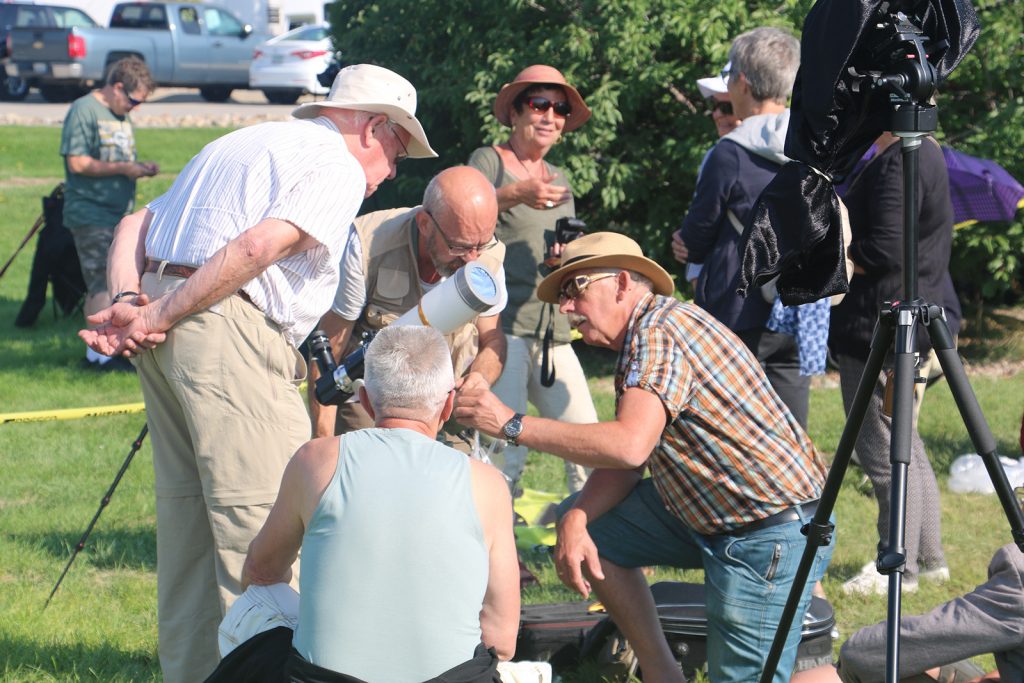
Thirty-nine wonderful folks from The Netherlands came to Agate Fossil Beds National Monument to view the eclipse. They are getting the final settings just right on their telescope.
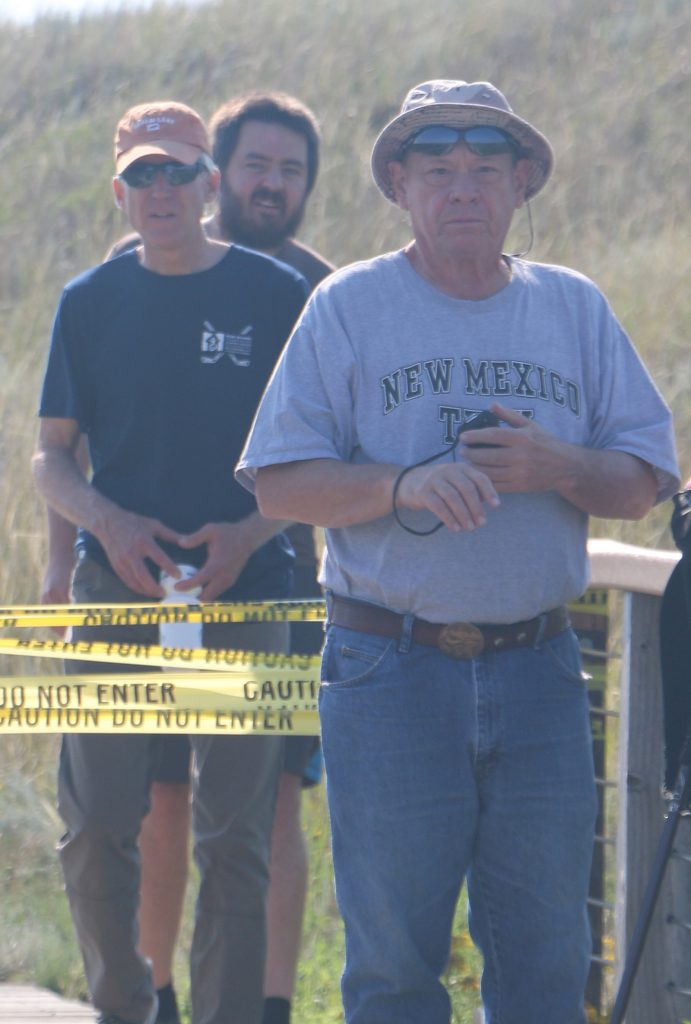
See those two guys in the back? They’re called assholes. They climbed under the roped off area at Agate Fossil Beds National Monument and went hiking on the trails. It’s a shame they didn’t get bit by a rattlesnake. There was no cell service and park rangers were elsewhere in the park. Don’t be an asshole. If an area is roped off in a national park or monument, it’s been done for your own safety.
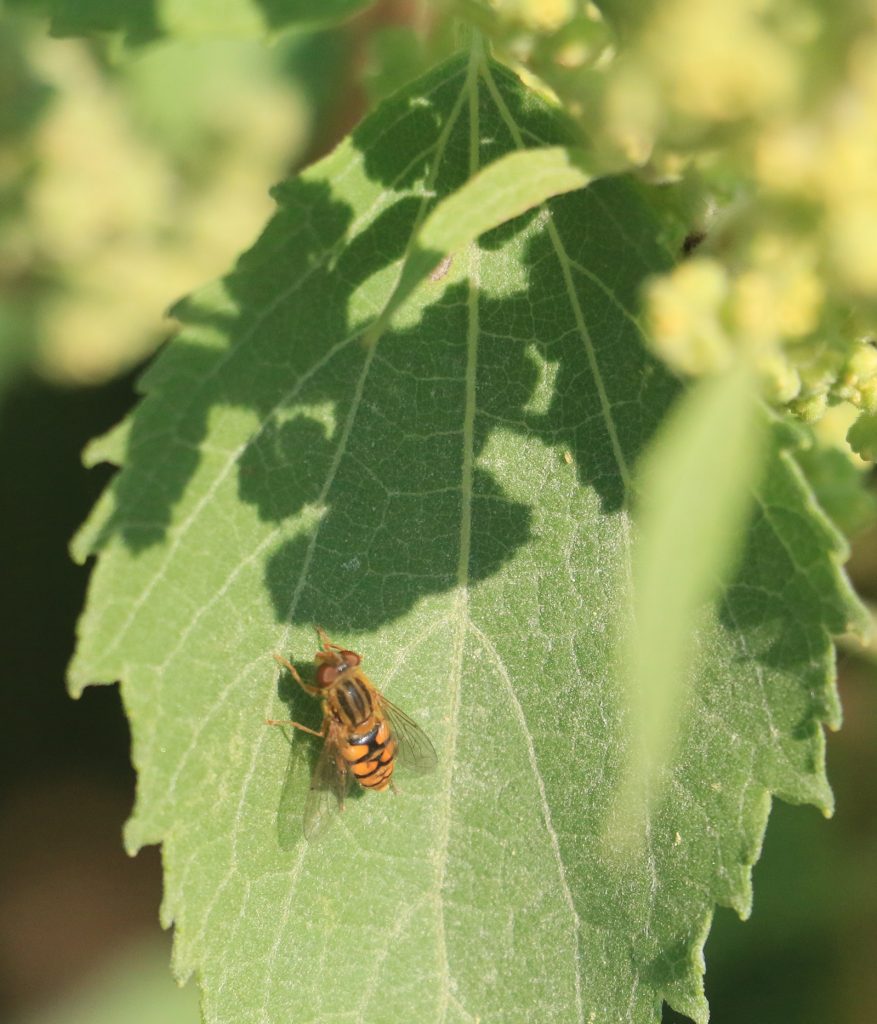
Just hanging on a leaf. This little critter is waiting for the total solar eclipse to start at Agate Fossil Beds National Monument. It’s 9:36 a.m. It will start in less than an hour.
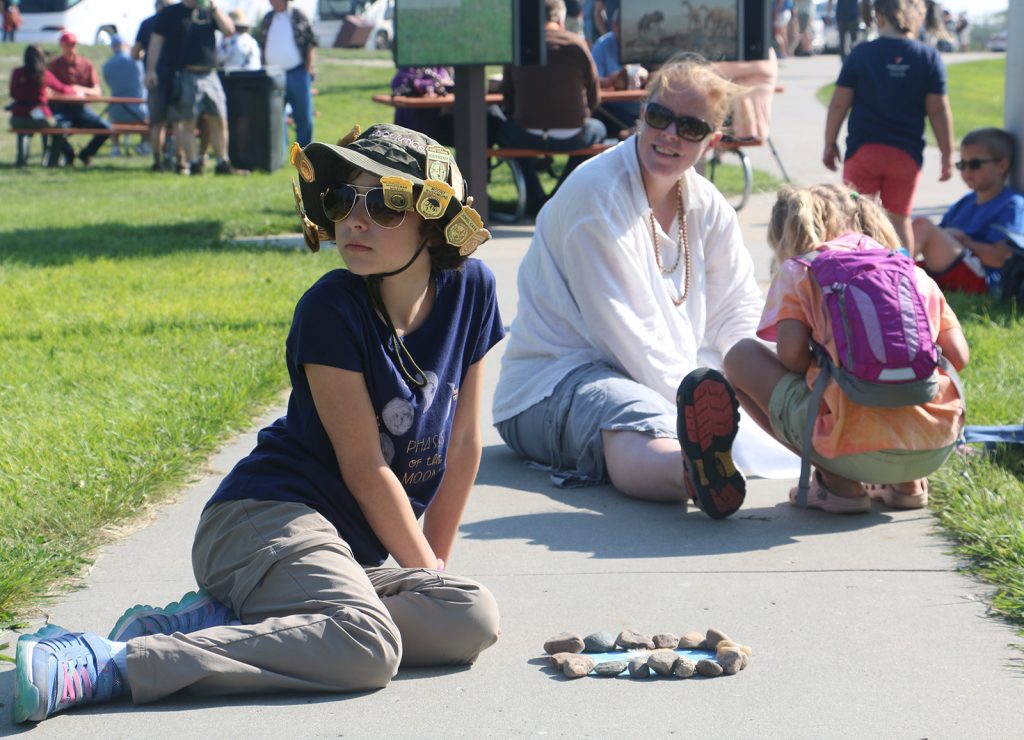
Many families with children spend time doing projects on their own, with their parents and with the help of park rangers. Here, Hanya Simon, of Philadelphia, Pennsylvania, stares off into the distance after making a picture with feathers in the sun. She and her family spent time in several national parks in South Dakota before comeing to Agate Fossil Beds National Monument for the total solar eclipse.
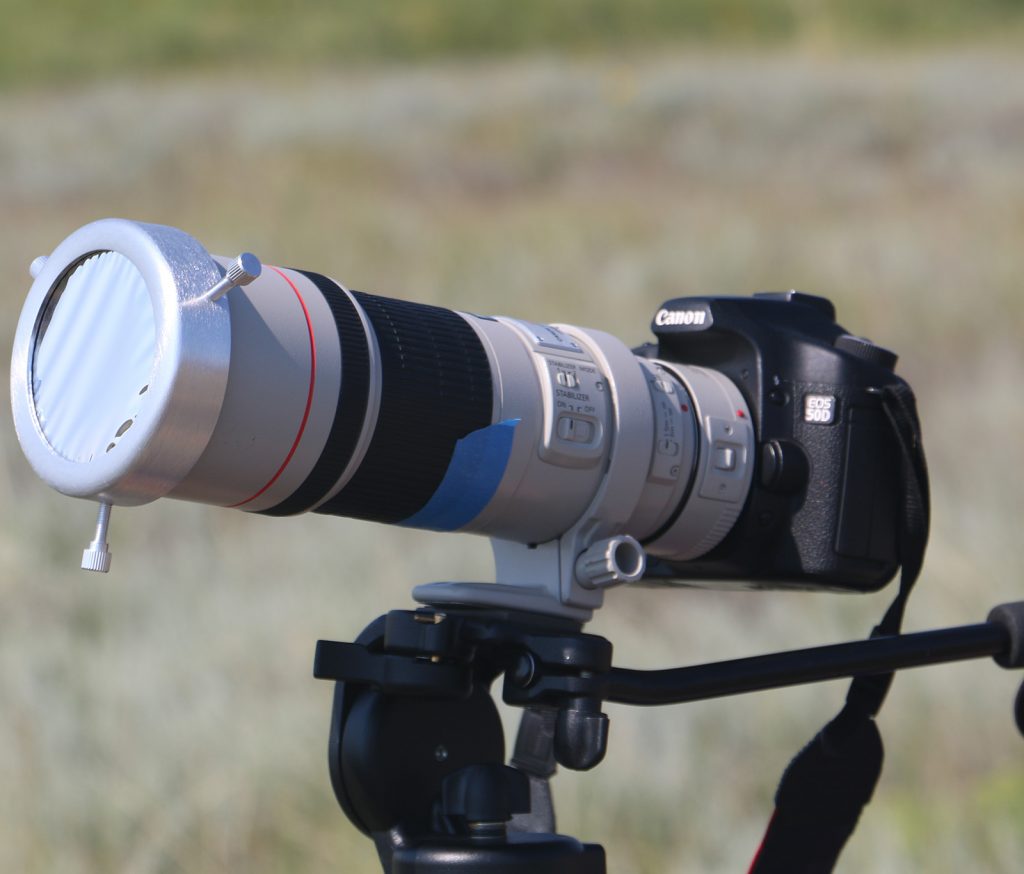
This is Ron Banfiel’s camera. Three years ago, he and his wife traveled by car between Denver, Colorado and North Dakota. They made a stop at Agate Fossil Beds. The Banfiels have an interest in paleontology and astronomy. when they saw the total solar eclipse was coming through Agate, they thought the park was their best chance to see the event. The couple hail from Flagstaff, Arizona. Banfiel said he couldn’t image a better place to see a solar eclipse.
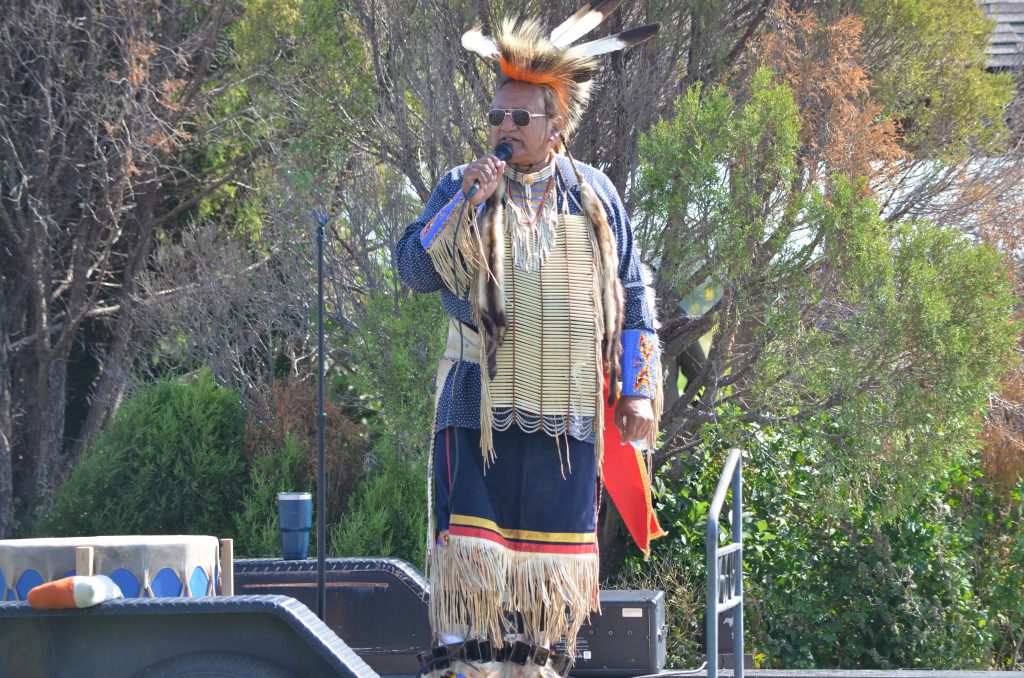
Lakota Kelly Looking Horse speaks to the crowd in full regalia at Agate Fossil Beds National Monument. This is one of my favorite photos.
If you’d like to read my story about what Kelly Looking Horse had to say, you can find it at the Star-Herald.
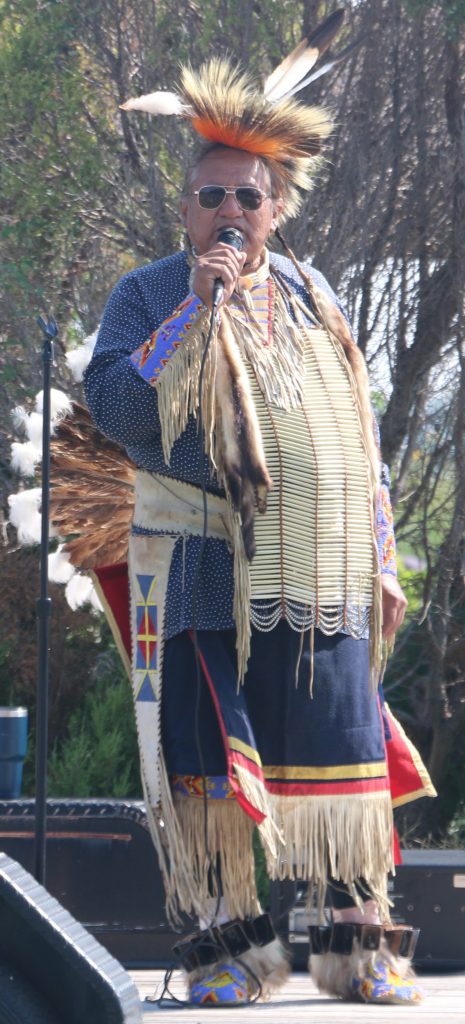
As Kelly Looking Horse turns, you can see part of the feathers that make up the back of his outfit. He knows every previous owner of his clothing. It is part of his heritage and he will one day pass it on to another Lakota.
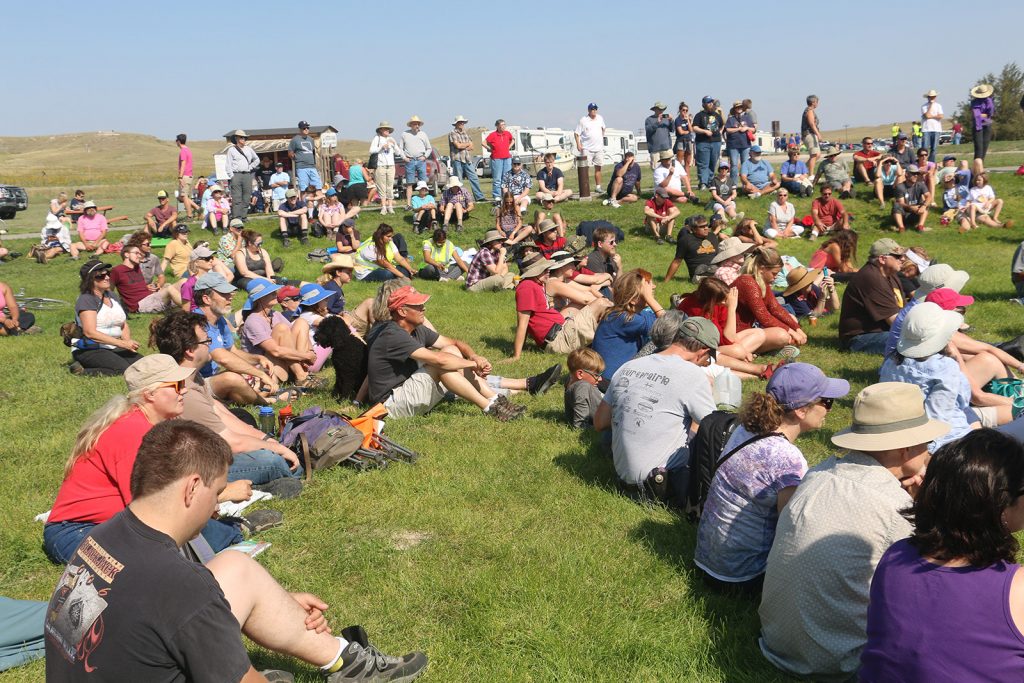
Just some of the crowd who gathered around to listen to Kelly Looking Horse at Agate Fossil Beds National Monument.
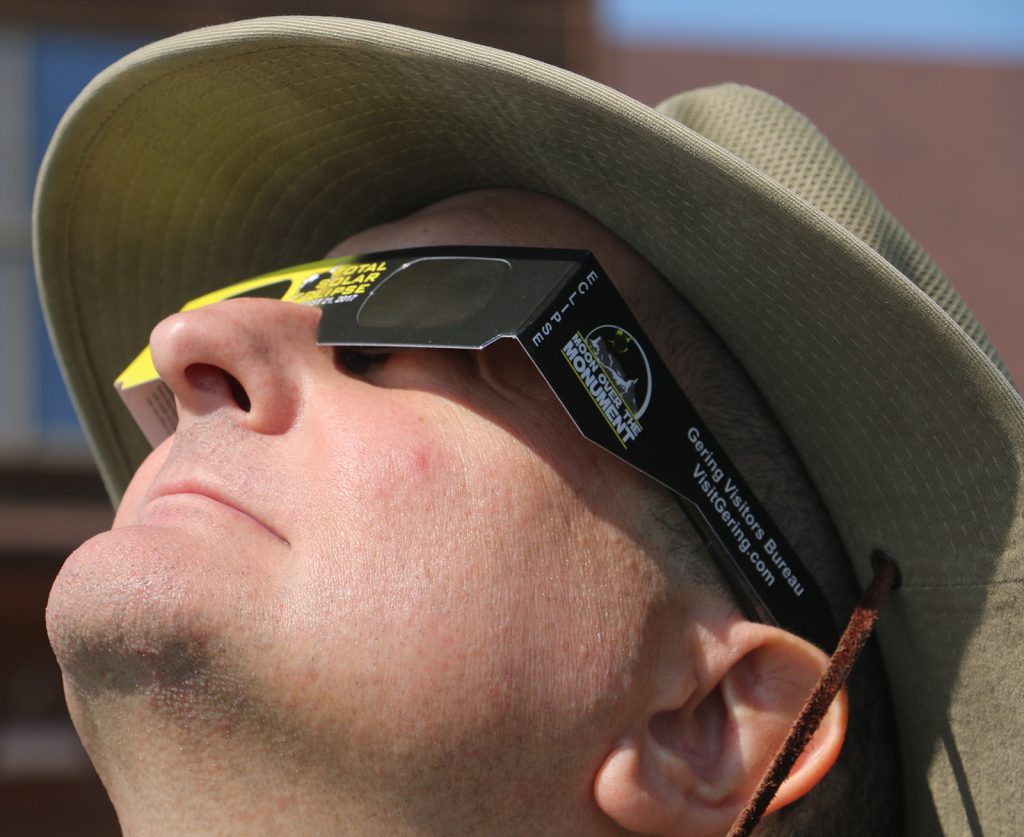
Paul North looks at the total solar eclipse at Agate Fossil Beds National Monument. He called first contact about 15 minutes ago.
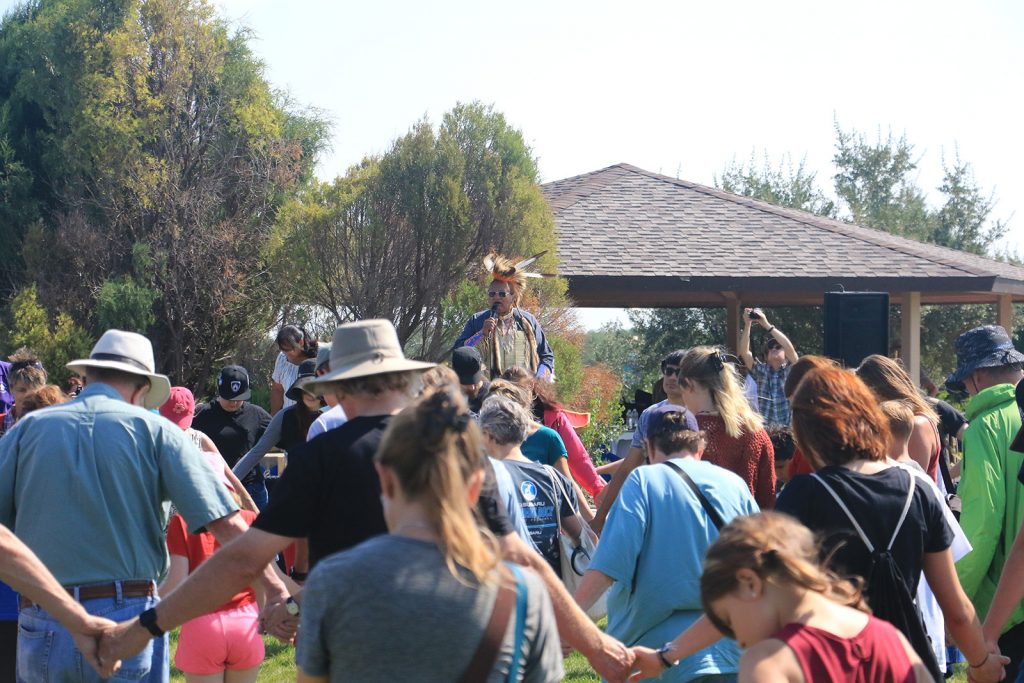
After talking to the crowd for about 45 minutes, Kelly Looking Horse gathered the people together in four circles to dance. At the end of the dance, they turned around and greeted each other as friends. Eventually, the crowd dispersed to view the total solar eclipse at Agate Fossil Beds National Monument.
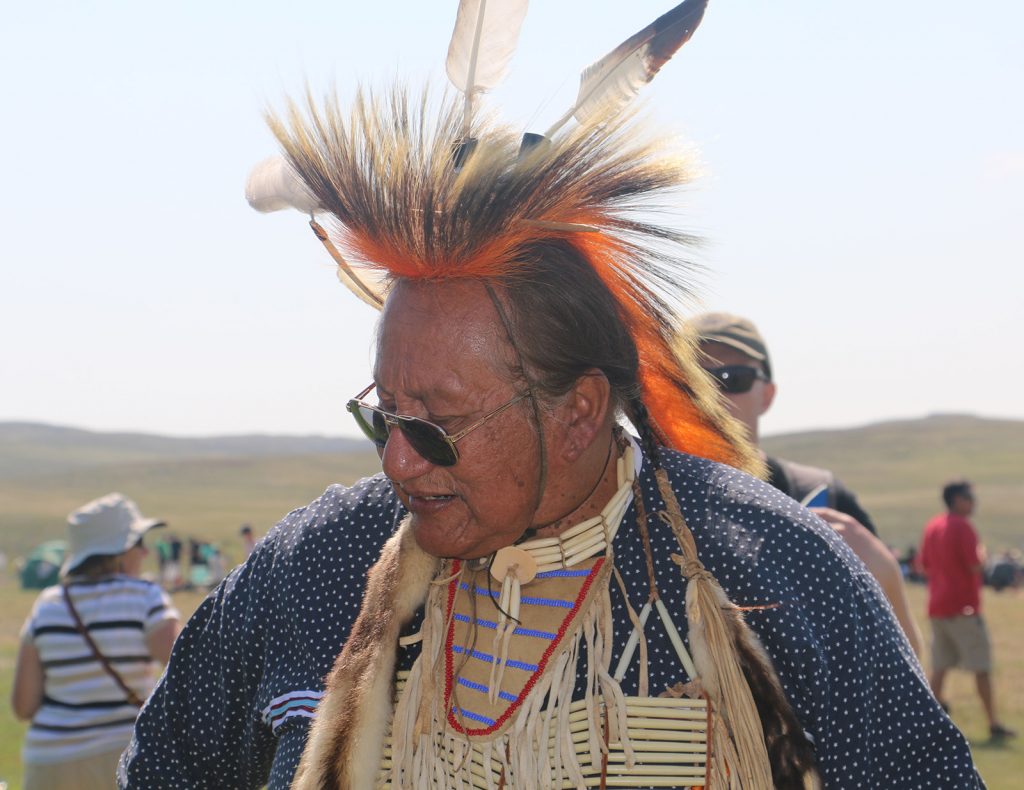
Though it may seem as if a spotlight has been turned on Kelly Looking Horse, this is how the sunlight was projected onto the Earth during the partial phase of the total solar eclipse at Agate Fossil Beds National Monument. It is also my favorite photograph of Kelly Looking Horse.
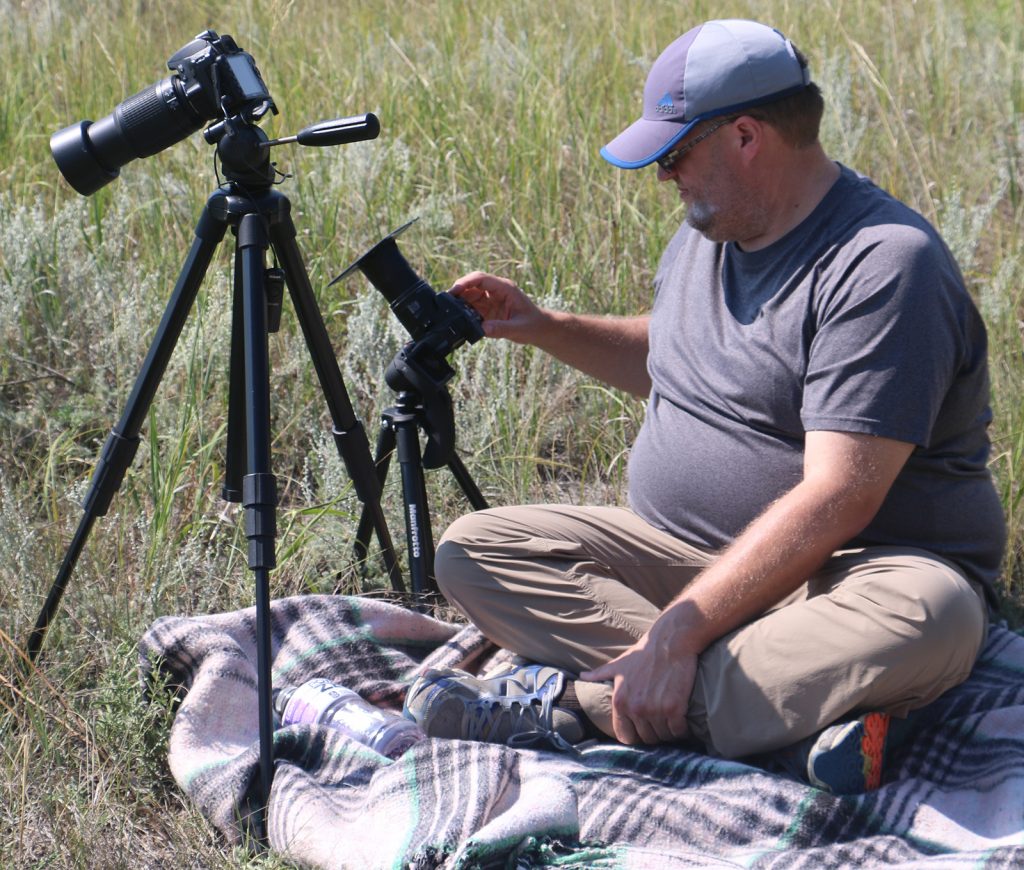
Jeff Leanna takes photos of the total solar eclipse during first contact at Agate Fossil Beds National Monument. Jeff was kind enough to loan me his tripod and filter so I could snap a few photos. But that’s what the day was all about – people sharing, talking, laughing, and experiencing a moment in time.
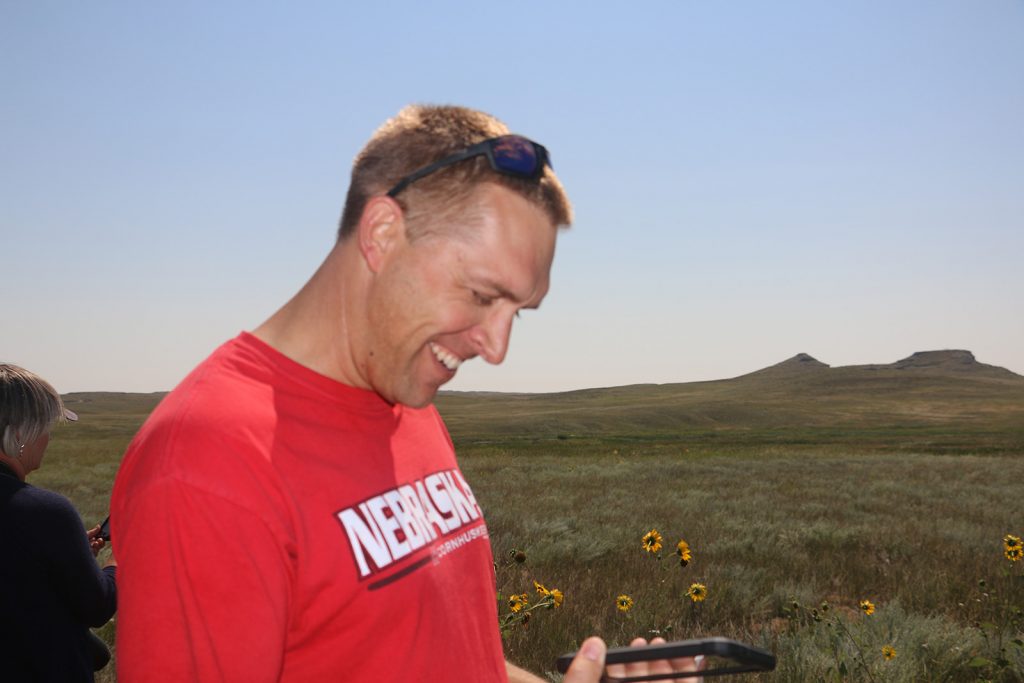
This isn’t the best photo ever taken of Matt Salomon, but I use it here to demonstrate what we saw with our eyes. As the sun neared totality, the sky and everything around us looked as if it was illuminated by an artificial spotlight.
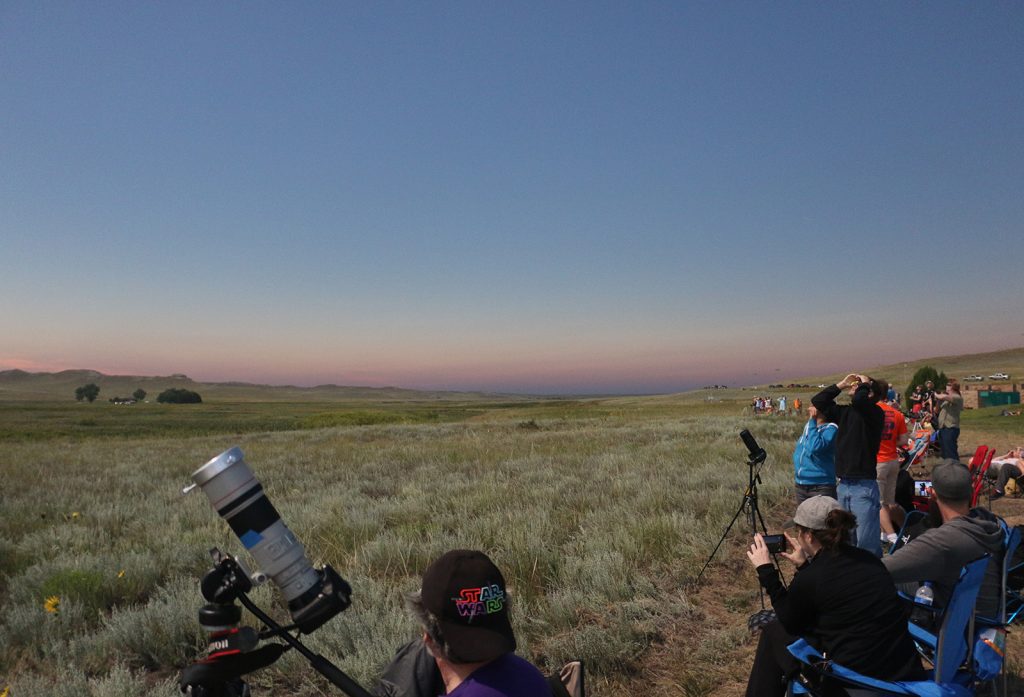
Moments before totality, you could see the Moon’s shadow approaching Agate Fossil Beds National Monument. When it finally arrive and blocked the sun, a cheer came over the crowd.

The moon begins eclipsing the sun over Agate Fossil Beds National Monument. Sun spots can be seen on the sun.
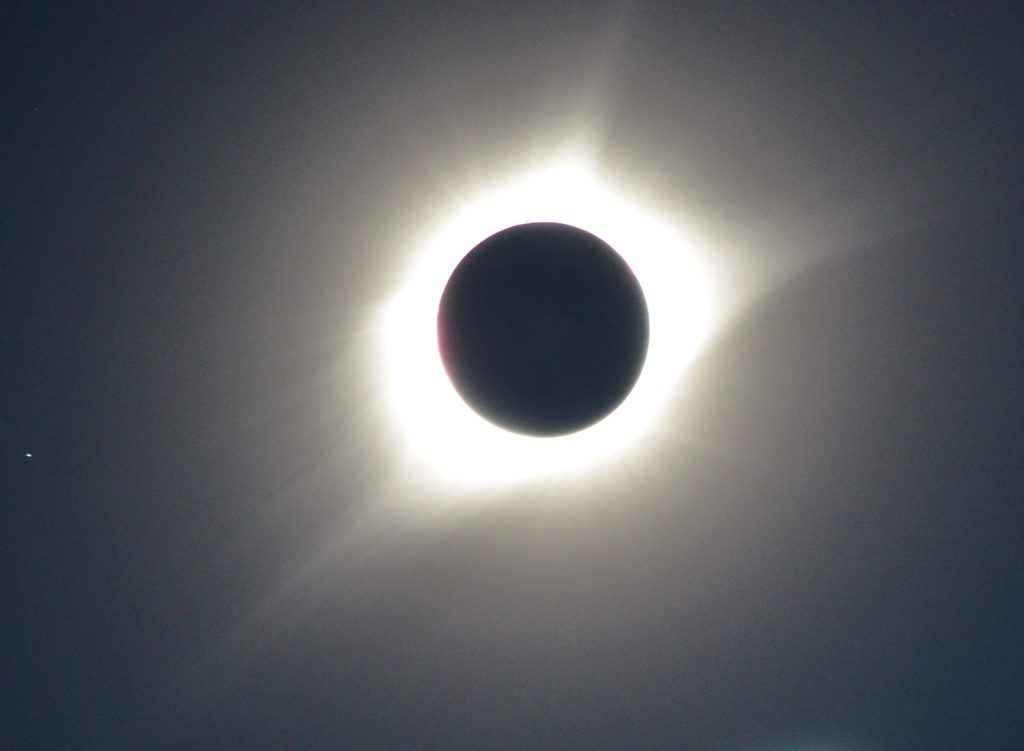
This is the best photograph I have of totality. It is over Agate Fossil Beds National Monument. The spot on the left is, I think, Regulus, but I’m not an astronomer and I can’t be 100 percent sure that’s what it is.
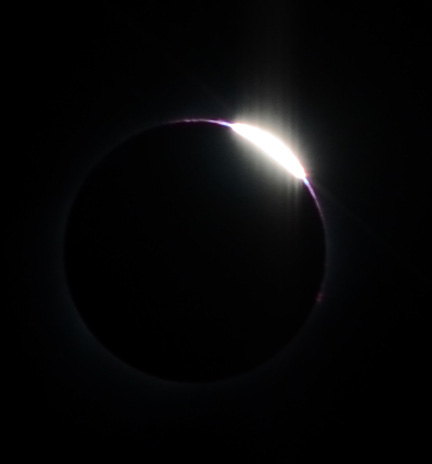
My best photo moments after the total eclipse of the sun at Agate Fossil Beds National Monument. You can see the beginning of the diamond ring effect.
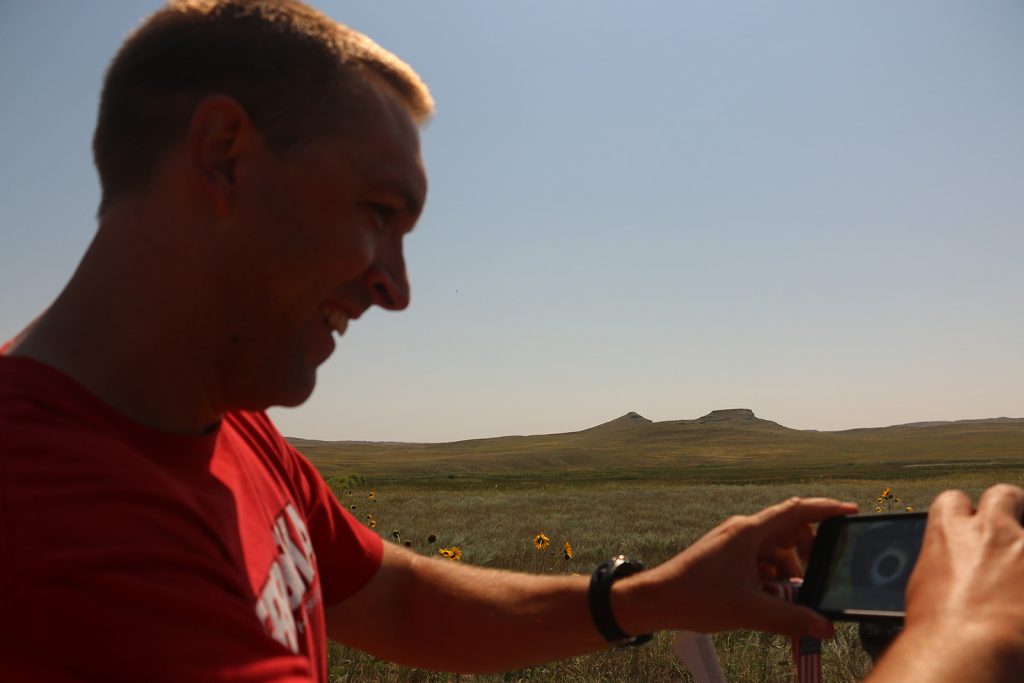
After totality, everyone was sharing the pictures they got. Here, Matt Salomon, of Scottsbluff, takes a picture of the photo Ron Banfiel, of Flagstaff, Arizona, took. Matt jokingly said he was going to take credit it for it.
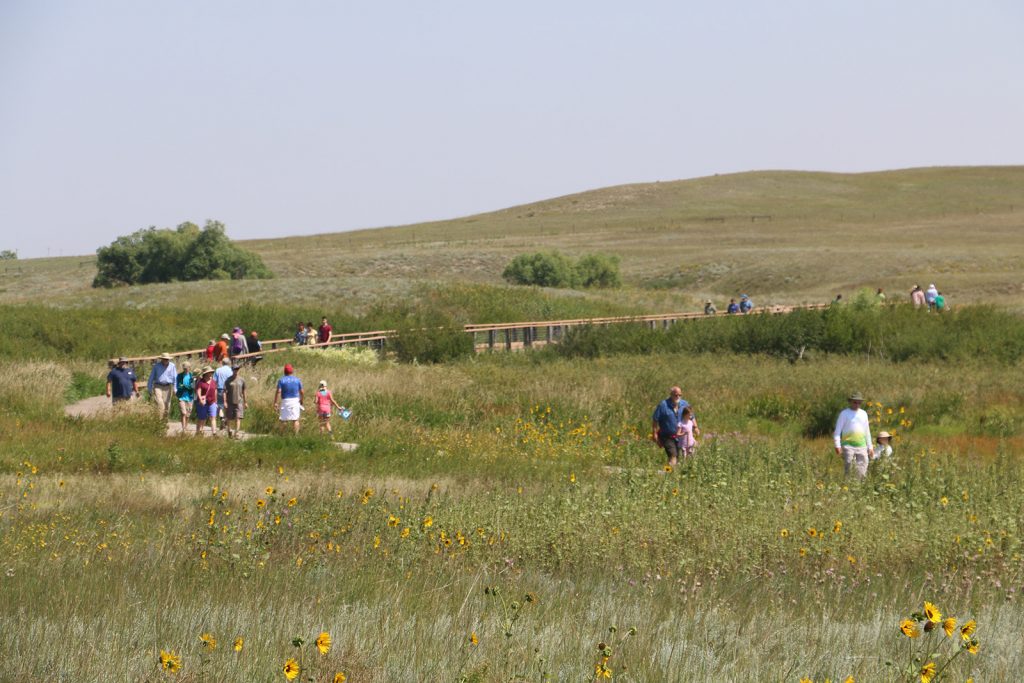
Once the total solar eclipse was over, park rangers opened the trail at Agate Fossil Beds National Monument.
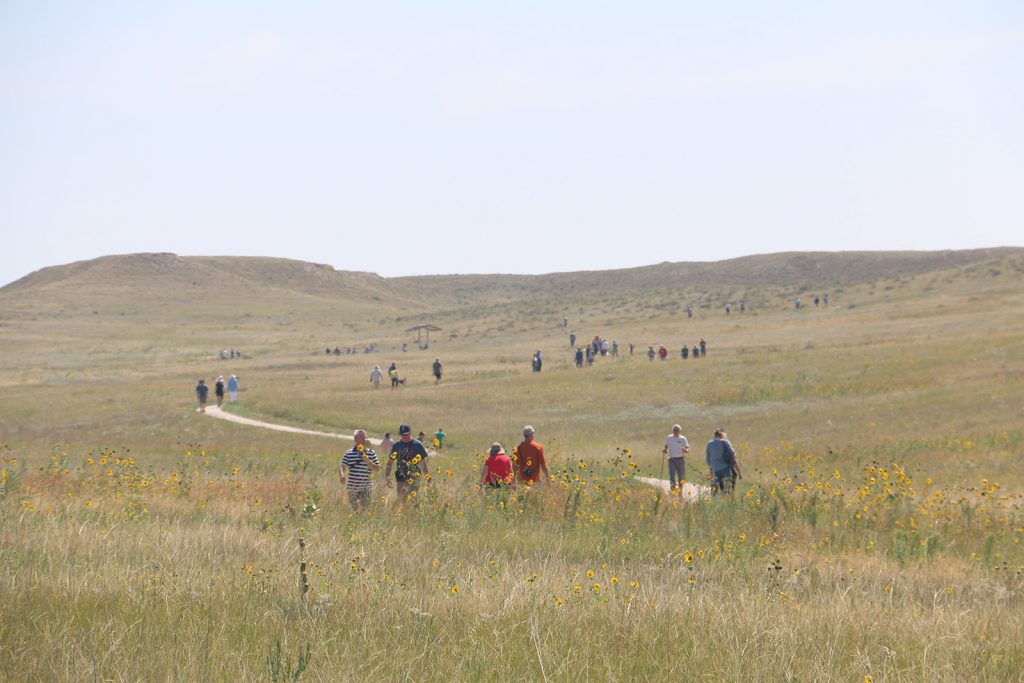
Folks hike along the trail at Agate Fossil Bed National Monument after the total solar eclipse on Monday, Auguse 21, 2017. I can’t tell if the guy in the striped shirt stole that sunflower or if it’s just a trick of the eye.
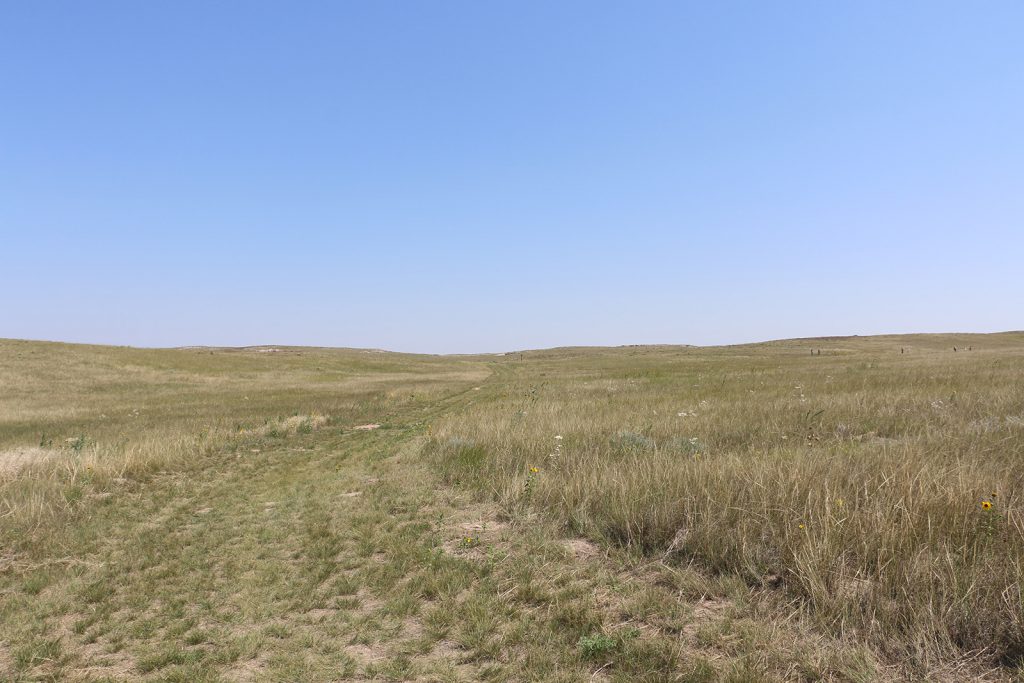
The Bone Bed trail. You have to travel along this trail to get back to my car, which was parked at a park ranger’s home. On this trail, you’ll see Thomas Cook’s grave and the Bone Cabin.
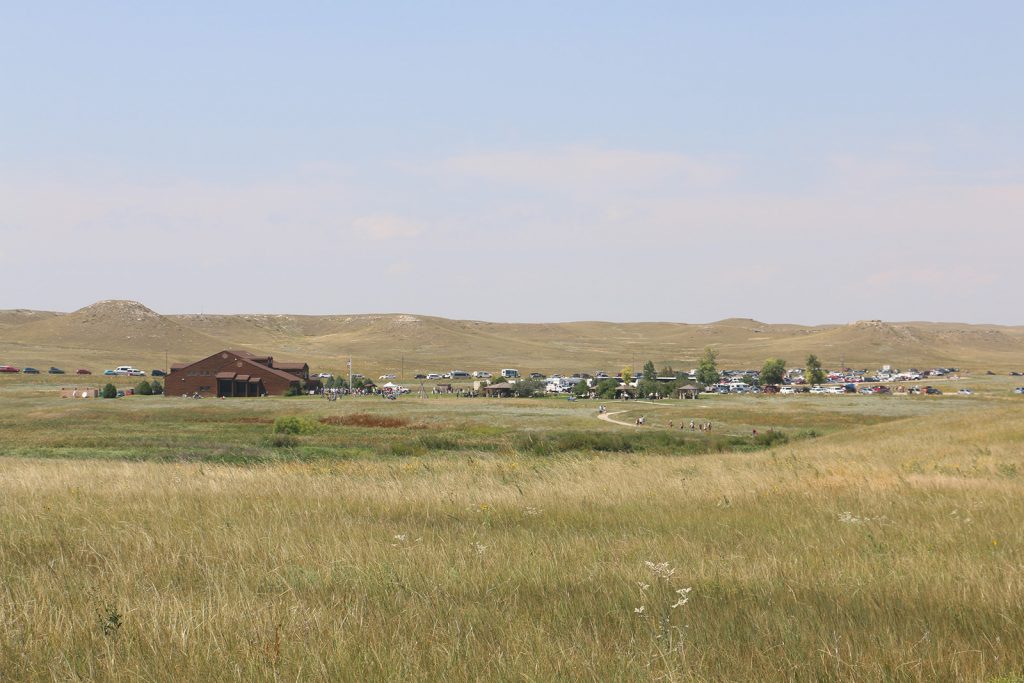
The visitors center at Agate Fossil Beds National Monument at 1:35 p.m. There are still thousands of visitors in the park after witnessing a total solar eclipse.

John Cook’s grave is just a short walk off the trail to the Bone Cabin. Near his grave is a bench to rest on. From the bench, there is a beautiful view for you to take some time to reflect on nature, or anything else.
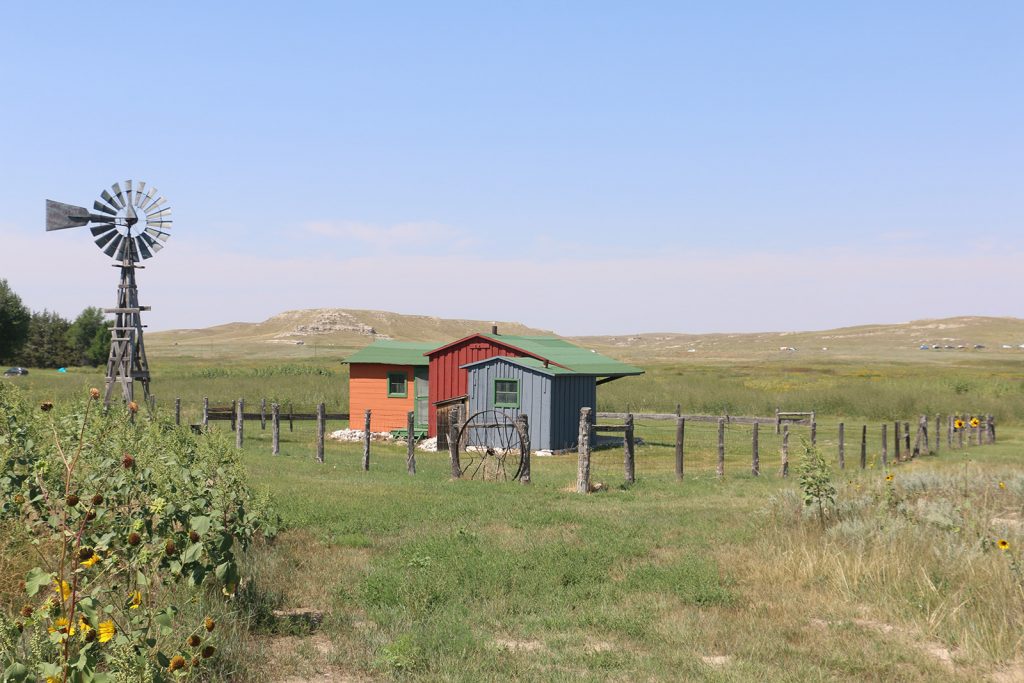
The Bone Cabin at Agate Fossil Beds National Monument. You can see my car in the left, middle part of this picture. You can see some of the cars parked on the side of the road in the distance.
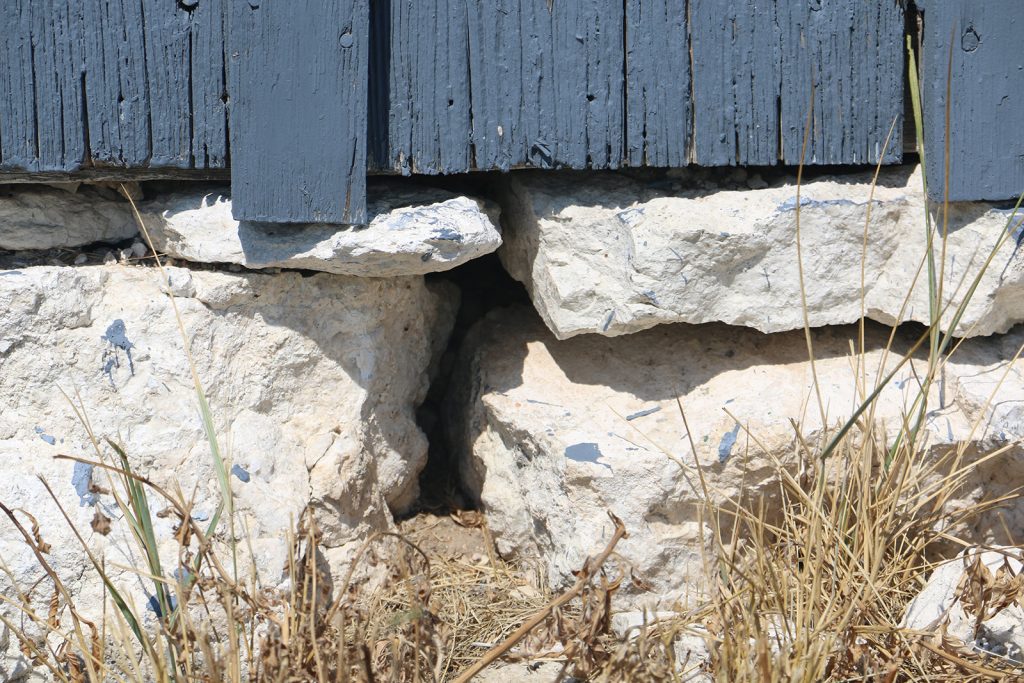
There is a rattlesnake in this hole. Paul and I can hear him. I walked up to the Bone Cabin and tried to look in the window. I’m too short to see inside. I think I walked on past the rattlesnake. The window is about six feet up and two feet to the right of this hole. When Paul walked up to the window, he said, “Oh shit! There’s a rattlesnake. Quick come take its picture.” I wasn’t quick enough. I saw its rattle and about six inches of snake before it disappeared. Paul was happy. He got to see a total solar eclipse and his first live rattlesnake in the same day.
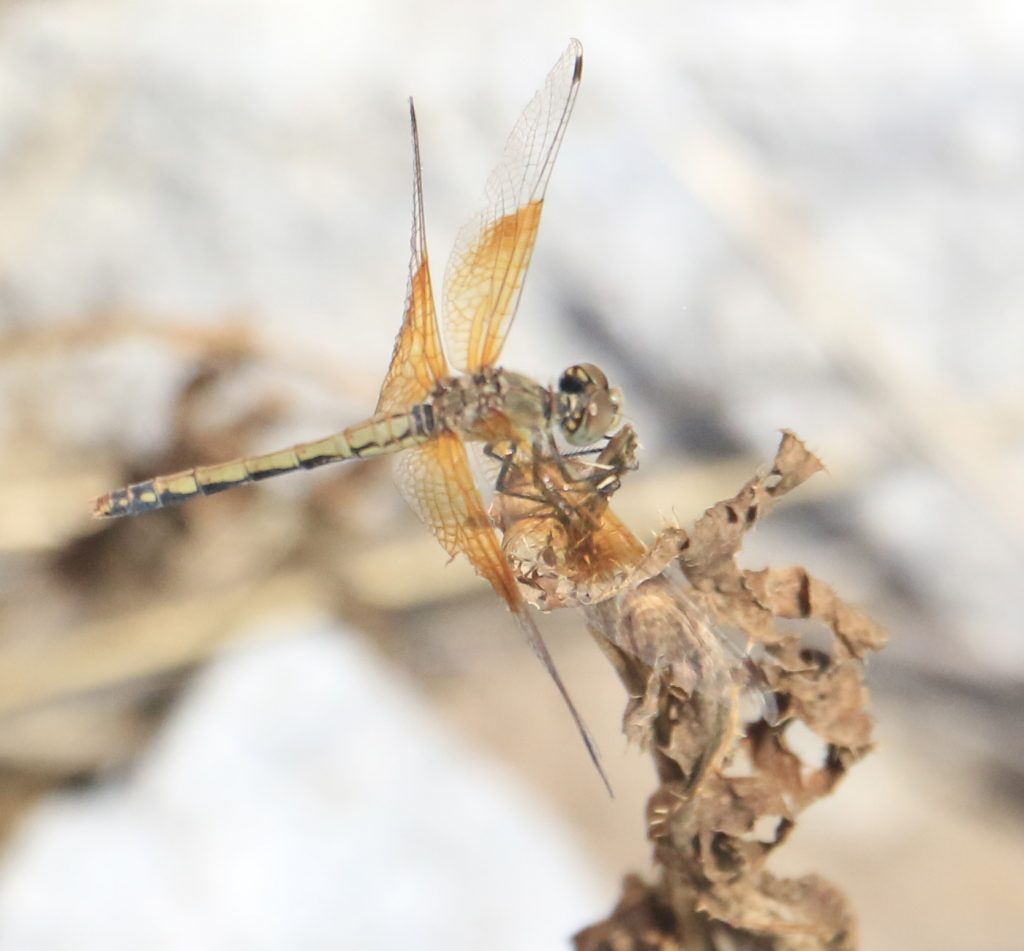
Though I didn’t get to photograph the rattlesnake, I did get this picture of a dragonfly outside the Bone Cabin at Agate Fossil Beds National Monument. I then walked to my car about 100 feet away and drove to get a signal so I could turn in my stories and photographs to the Star-Herald.
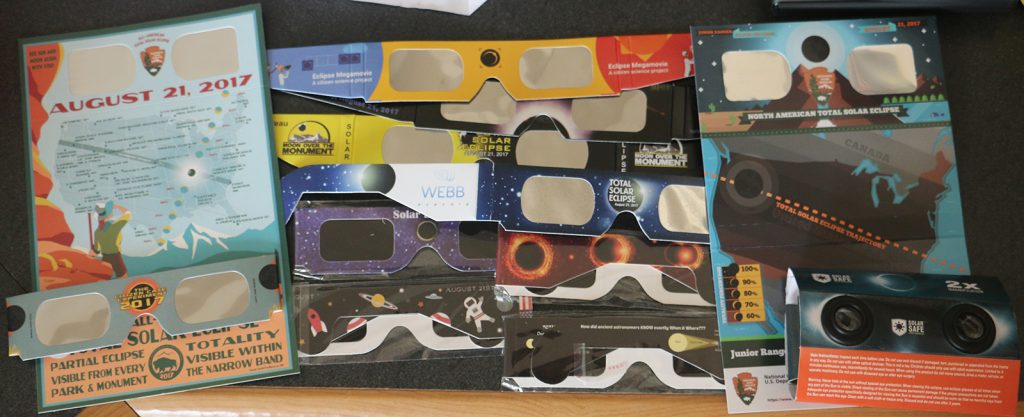
This is my collection of eclipse glasses I gathered. I will keep a couple for sentimental reasons. The rest, I have given to Paul to take to work at Gering High School. Kory Knight is collecting them to send to Astronomers Without Borders. They will distribute them to folks who can’t afford glasses for the next total solar eclipse in the world. If you want to get rid of yours, drop by the Star-Herald and give them to me. I’ll make sure they get where they need to be.

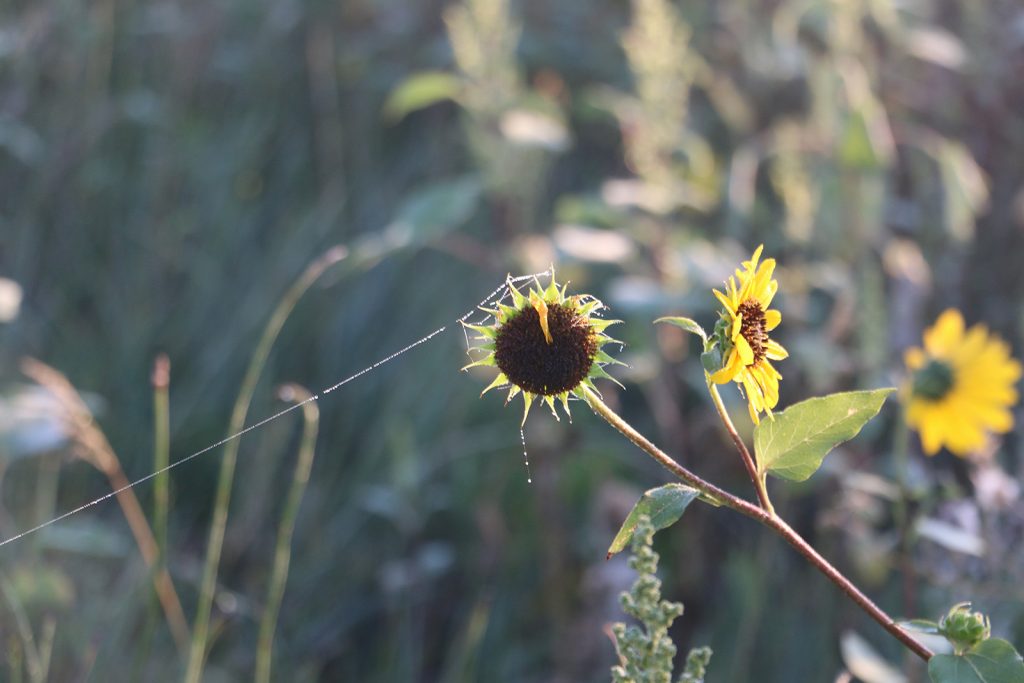
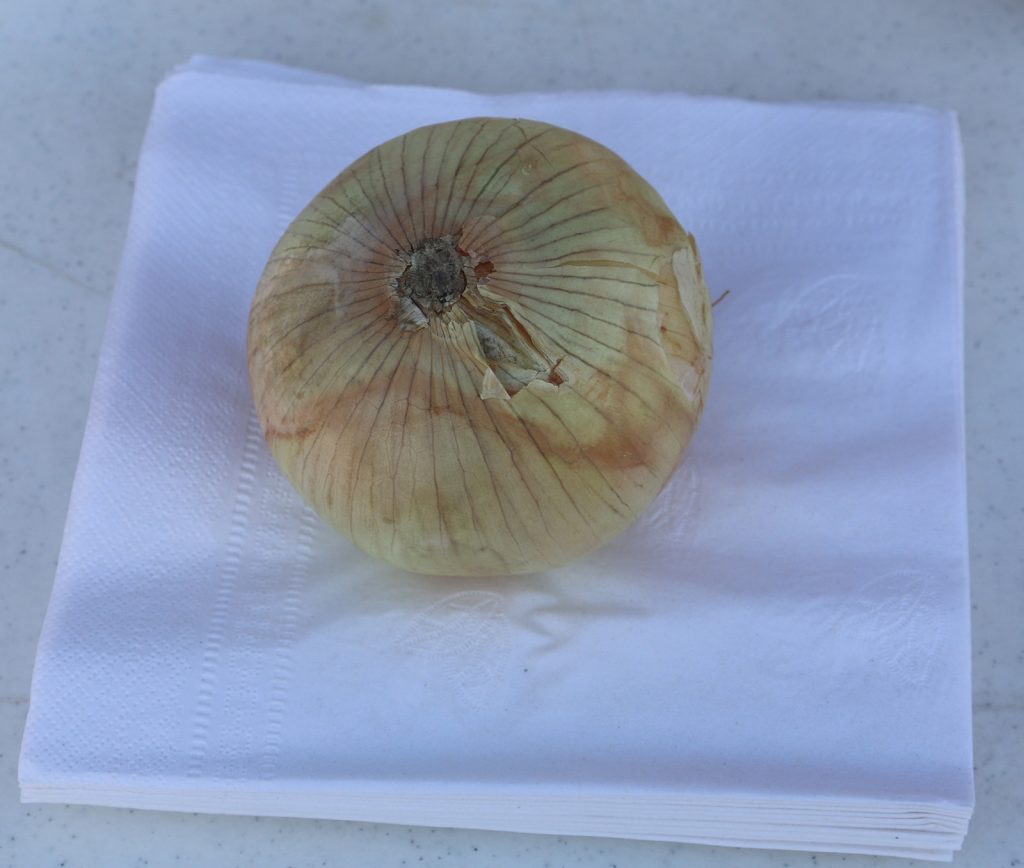

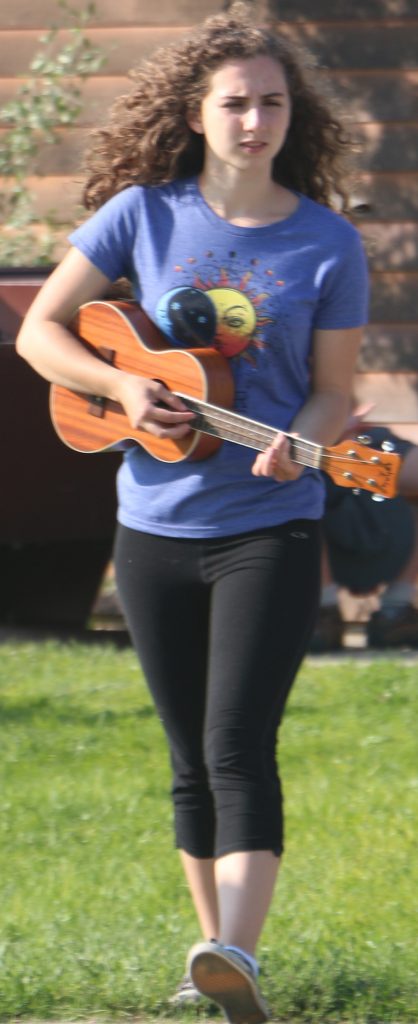
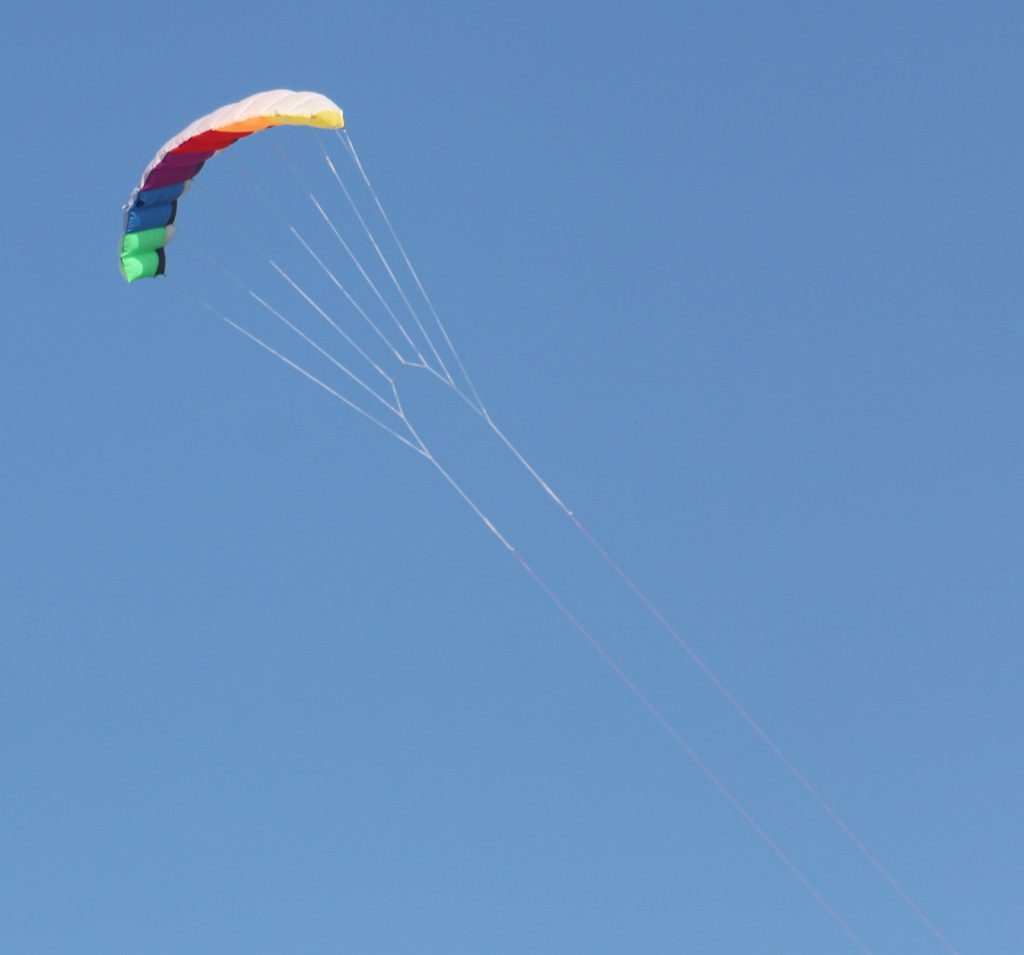
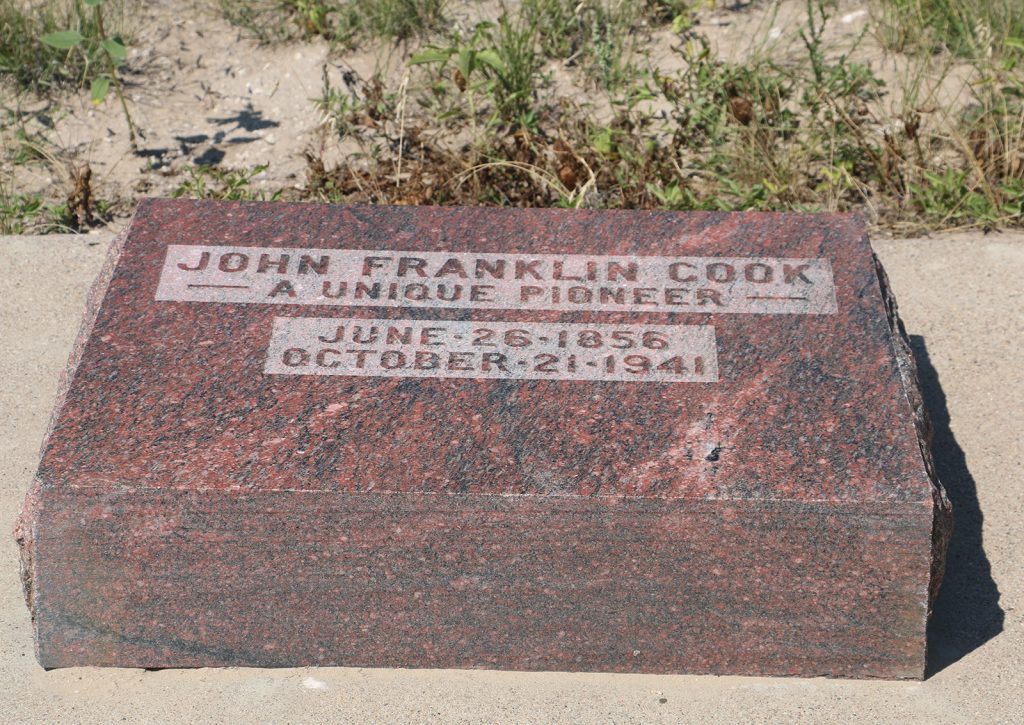
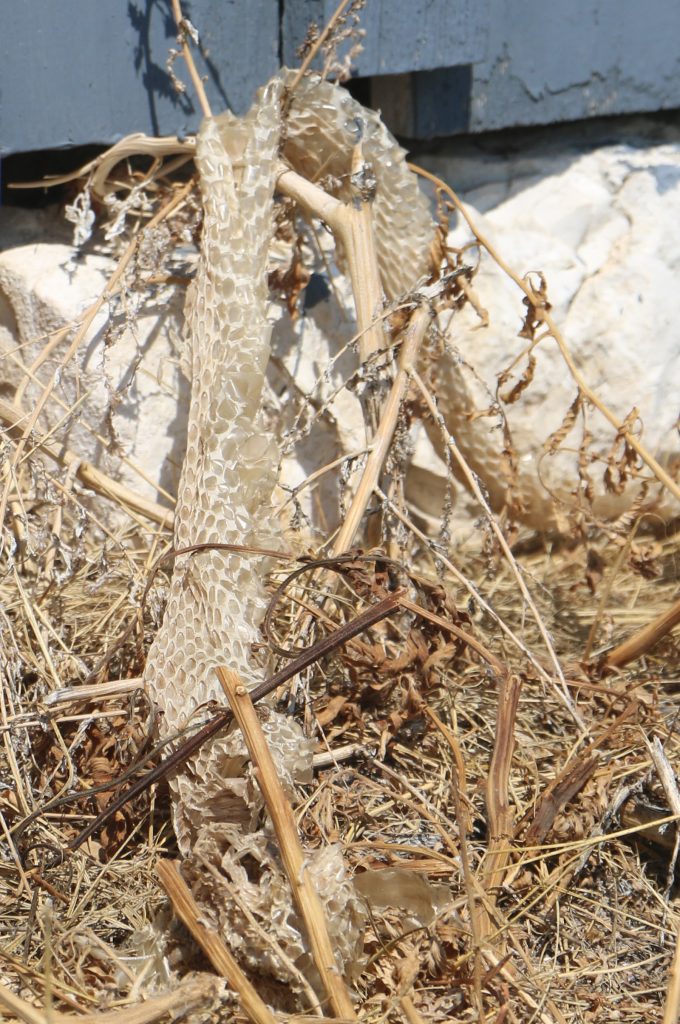
Katie Bradshaw
Loved reading this, since I was there, too. I need to write my own post! I will not have as many photos, and they will not be as good. One of the things I miss about being a journalist is the license to be nosy.
Irene North
I’m sure whatever you write will be really good. You had another perspective of the day and I look forward to reading it.
Jayne McElhone
How fabulous, what an experience and what super photos xxx
Paul North
It was a fantastic experience. There will be another total solar eclipse visible from the U.S. in seven years and we are making plans to see that one too 🙂
Jayne McElhone
Is Irene a professional photographer or is it just a hobby? The pics are lovely x
Paul North
Irene is a journalist and works for the local newspaper so photography is part of her job.
AJ Legault
Wonderful pictures Irene. May the park share them?
Irene North
Yes, feel free.
Steve Frederick
Excellent. Feel free to take my job when I’m done with it.
Irene North
I’m working on it. I just spent 12 hours with Sandra Reddish at Fort Robinson and a lot of land around the fort.